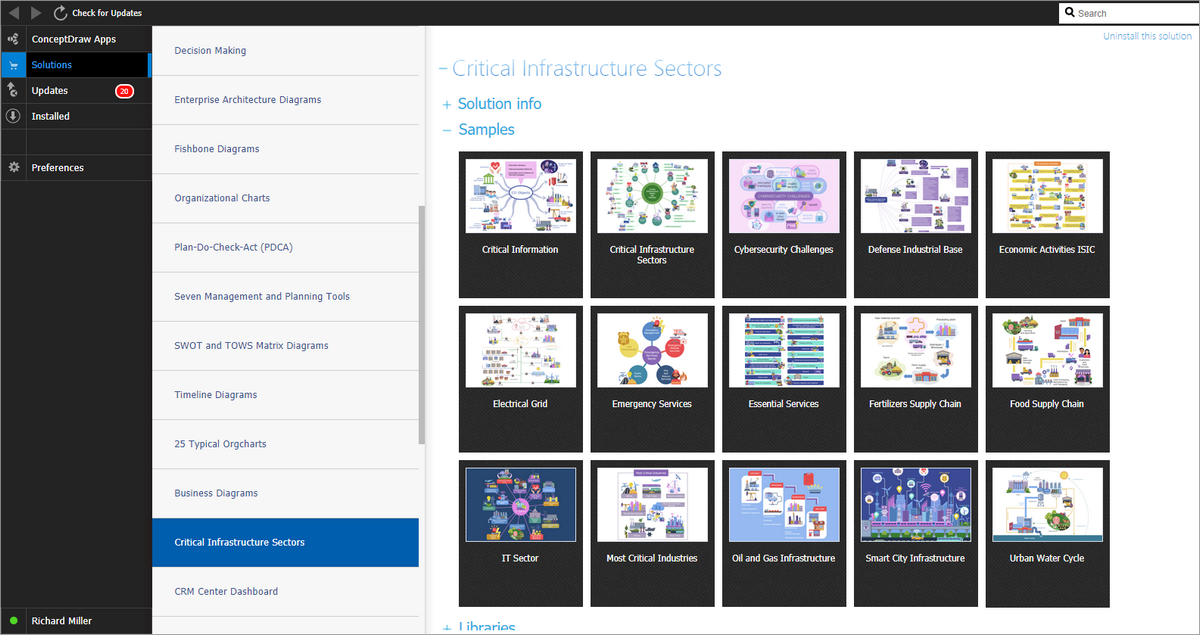- Electric and Telecom Plans Free
- Fire and Emergency Plans Free
- Floor Plans Free
- Plant Layout Plans Free
- School and Training Plans Free
- Seating Plans Free
- Security and Access Plans Free
- Site Plans Free
- Sport Field Plans Free
- Business Process Diagrams Free
- Business Process Mapping Free
- Classic Business Process Modeling Free
- Cross-Functional Flowcharts Free
- Event-driven Process Chain Diagrams Free
- IDEF Business Process Diagrams Free
- Logistics Flow Charts Free
- Workflow Diagrams Free
- ConceptDraw Dashboard for Facebook Free
- Mind Map Exchange Free
- MindTweet Free
- Note Exchange Free
- Project Exchange Free
- Social Media Response Free
- Active Directory Diagrams Free
- AWS Architecture Diagrams Free
- Azure Architecture Free
- Cisco Network Diagrams Free
- Cisco Networking Free
- Cloud Computing Diagrams Free
- Computer Network Diagrams Free
- Google Cloud Platform Free
- Interactive Voice Response Diagrams Free
- Network Layout Floor Plans Free
- Network Security Diagrams Free
- Rack Diagrams Free
- Telecommunication Network Diagrams Free
- Vehicular Networking Free
- Wireless Networks Free
- Comparison Dashboard Free
- Composition Dashboard Free
- Correlation Dashboard Free
- Frequency Distribution Dashboard Free
- Meter Dashboard Free
- Spatial Dashboard Free
- Status Dashboard Free
- Time Series Dashboard Free
- Basic Circle-Spoke Diagrams Free
- Basic Circular Arrows Diagrams Free
- Basic Venn Diagrams Free
- Block Diagrams Free
- Concept Maps Free
- Family Tree Free
- Flowcharts Free
- Basic Area Charts Free
- Basic Bar Graphs Free
- Basic Divided Bar Diagrams Free
- Basic Histograms Free
- Basic Line Graphs Free
- Basic Picture Graphs Free
- Basic Pie Charts Free
- Basic Scatter Diagrams Free
- Aerospace and Transport Free
- Artwork Free
- Audio, Video, Media Free
- Business and Finance Free
- Computers and Communications Free
- Holiday Free
- Manufacturing and Maintenance Free
- Nature Free
- People Free
- Presentation Clipart Free
- Safety and Security Free
- Analog Electronics Free
- Audio and Video Connectors Free
- Basic Circuit Diagrams Free
- Chemical and Process Engineering Free
- Digital Electronics Free
- Electrical Engineering Free
- Electron Tube Circuits Free
- Electronic Block Diagrams Free
- Fault Tree Analysis Diagrams Free
- GHS Hazard Pictograms Free
- Home Automation and Wiring Free
- Mechanical Engineering Free
- One-line Diagrams Free
- Power Сircuits Free
- Specification and Description Language (SDL) Free
- Telecom and AV Circuits Free
- Transport Hazard Pictograms Free
- Data-driven Infographics Free
- Pictorial Infographics Free
- Spatial Infographics Free
- Typography Infographics Free
- Calendars Free
- Decision Making Free
- Enterprise Architecture Diagrams Free
- Fishbone Diagrams Free
- Organizational Charts Free
- Plan-Do-Check-Act (PDCA) Free
- Seven Management and Planning Tools Free
- SWOT and TOWS Matrix Diagrams Free
- Timeline Diagrams Free
- Critical Infrastructure Sectors $35
- Australia Map Free
- Continent Maps Free
- Directional Maps Free
- Germany Map Free
- Metro Map Free
- UK Map Free
- USA Maps Free
- Customer Journey Mapping Free
- Marketing Diagrams Free
- Matrices Free
- Pyramid Diagrams Free
- Sales Dashboard Free
- Sales Flowcharts Free
- Target and Circular Diagrams Free
- Cash Flow Reports Free
- Current Activities Reports Free
- Custom Excel Report Free
- Knowledge Reports Free
- MINDMAP Reports Free
- Overview Reports Free
- PM Agile Free
- PM Dashboards Free
- PM Docs Free
- PM Easy Free
- PM Meetings Free
- PM Planning Free
- PM Presentations Free
- PM Response Free
- Resource Usage Reports Free
- Visual Reports Free
- House of Quality Free
- Quality Mind Map Free
- Total Quality Management TQM Diagrams Free
- Value Stream Mapping Free
- Astronomy Free
- Biology Free
- Chemistry Free
- Language Learning Free
- Mathematics Free
- Physics Free
- Piano Sheet Music Free
- Android User Interface Free
- Class Hierarchy Tree Free
- Data Flow Diagrams (DFD) Free
- DOM Tree Free
- Entity-Relationship Diagram (ERD) Free
- EXPRESS-G data Modeling Diagram Free
- IDEF0 Diagrams Free
- iPhone User Interface Free
- Jackson Structured Programming (JSP) Diagrams Free
- macOS User Interface Free
- Object-Role Modeling (ORM) Diagrams Free
- Rapid UML Free
- SYSML Free
- Website Wireframe Free
- Windows 10 User Interface Free
Critical Infrastructure Sectors
Critical infrastructure is the combination of organizations, facilities, supply chains, communication networks, and technologies of major importance for the country, society, national economy, life and safety of people. The specific infrastructure that each government considers critical can vary, but usually, 16 sectors are classified as critical infrastructure. Each of them is vital and overseen by a specific government agency. These include the energy sector, water and wastewater, food and agriculture, healthcare and public health, transportation systems, chemical sector, critical manufacturing, nuclear sector, defense industrial base, emergency services, communications, commercial facilities, financial services, dams sector, government facilities, and information technology. The assets, systems, services, and networks related to these sectors compose the base of everyday society life and activity.
Critical infrastructure is essential to maintain vital social functions and the economy and requires special attention, protection, reducing vulnerabilities, and strengthening for secure and resilient functioning and providing national security. Any kind of damage, destruction, or disabling of critical infrastructure has substantial consequences and can have a significant negative impact on social and economic well-being, the security of the country and citizens, public health, and the ability to conduct national defense.
The energy, healthcare, and transport sectors have the most value. The energy sector includes a net of electricity, oil, and natural gas resources and assets, which ensure a steady energy supply. Prolonged failure in the energy sector can cause disruptions and inability to many sectors of daily life, like electricity and water supply, transport, logistics, manufacturing, telecommunications, banking and financial system, medicine sector, retail sector, etc. The healthcare sector focuses on population health, protection, and recovery actions in cases of infectious diseases, natural disasters, and other incidents. Access to clean water is a requirement for all humanity's health. Transport infrastructure includes highways, railways, bridges and tunnels, and vehicles ensuring the day-to-day moving of people and goods across the country. Other sectors of critical infrastructure also have great value and are exposed to a limitless number of threats and risks.
Natural disasters, malicious behavior, criminal activity, terrorist attacks, interference of foreign actors are the main causes of destruction, incapacitation, and damage to critical infrastructure. It is important to provide protection of critical infrastructure from disruptions and failures to prevent the risk of their unavailability for some defined or undefined period, supply shortage, disruptions to public order, disorders in public safety and security, and other threats to the functioning of the community.
Currently critical industries widely use information technologies and digitalization. In this regard, cyber threats and cyber attacks that become a growing phenomenon, require special attention. The growing dependency on IT gave high importance to identification and protection against cyber threats and cyber attacks, vulnerabilities in different sectors, including government, health, education, transport, and financial sector, ensuring the protection of financial assets and stable access to them. Because the destruction of physical or virtual assets, systems, and networks can have a devastating impact on national security, economic security, public health, and safety.
Critical Infrastructure Sectors solution for ConceptDraw DIAGRAM software provides a set of examples and vector stencil libraries for designing infographics and diagrams about critical infrastructure sectors. Use them to develop means for the most efficient protection of critical infrastructure, energy sector and other ones, and rapid recovery in the case of disruptions. Illustrate your projects on the prevention of different physical, environmental, and cyber threats, development of information technology and detection equipment. Improve your projects to solve critical issues efficiently and decrease the detrimental effects of disruptions on society and citizens. Realize crisis management, communications, financial services, emergency services, and cybersecurity efficiently, show the results of testing new technologies and newest equipment for critical infrastructure protection, homeland security, and increasing resilience.
-
Buy this solution $35 -
Solution Requirements - This solution requires the following products to be installed:
ConceptDraw DIAGRAM v18 - This solution requires the following products to be installed:
-
Support for this Solution -
Helpdesk
The Critical Infrastructure Sectors solution has 16 libraries containing 250 vector graphics icons and 15 examples.
Design Elements — Chemical Sector
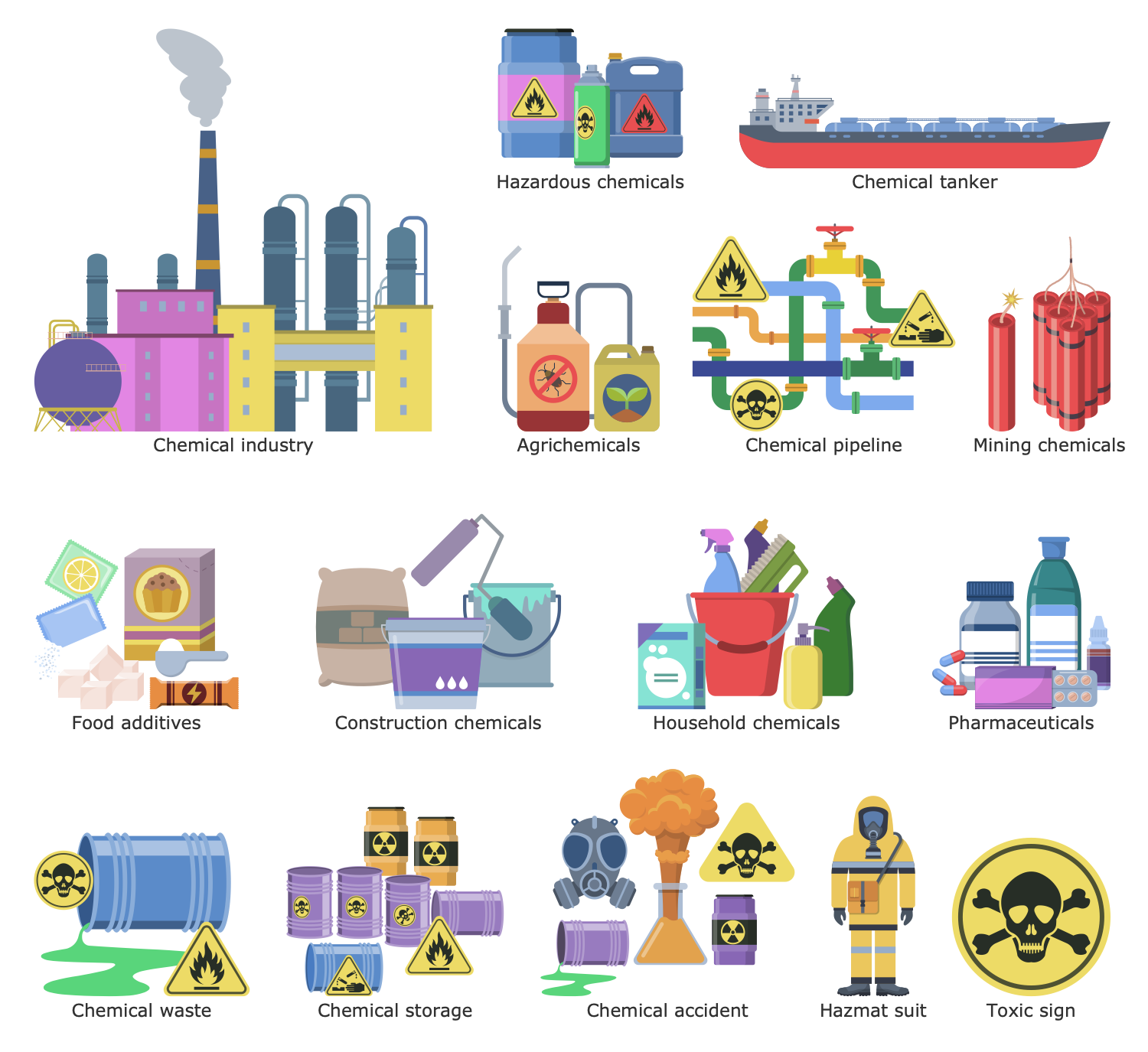
Design Elements — Commercial Facilities
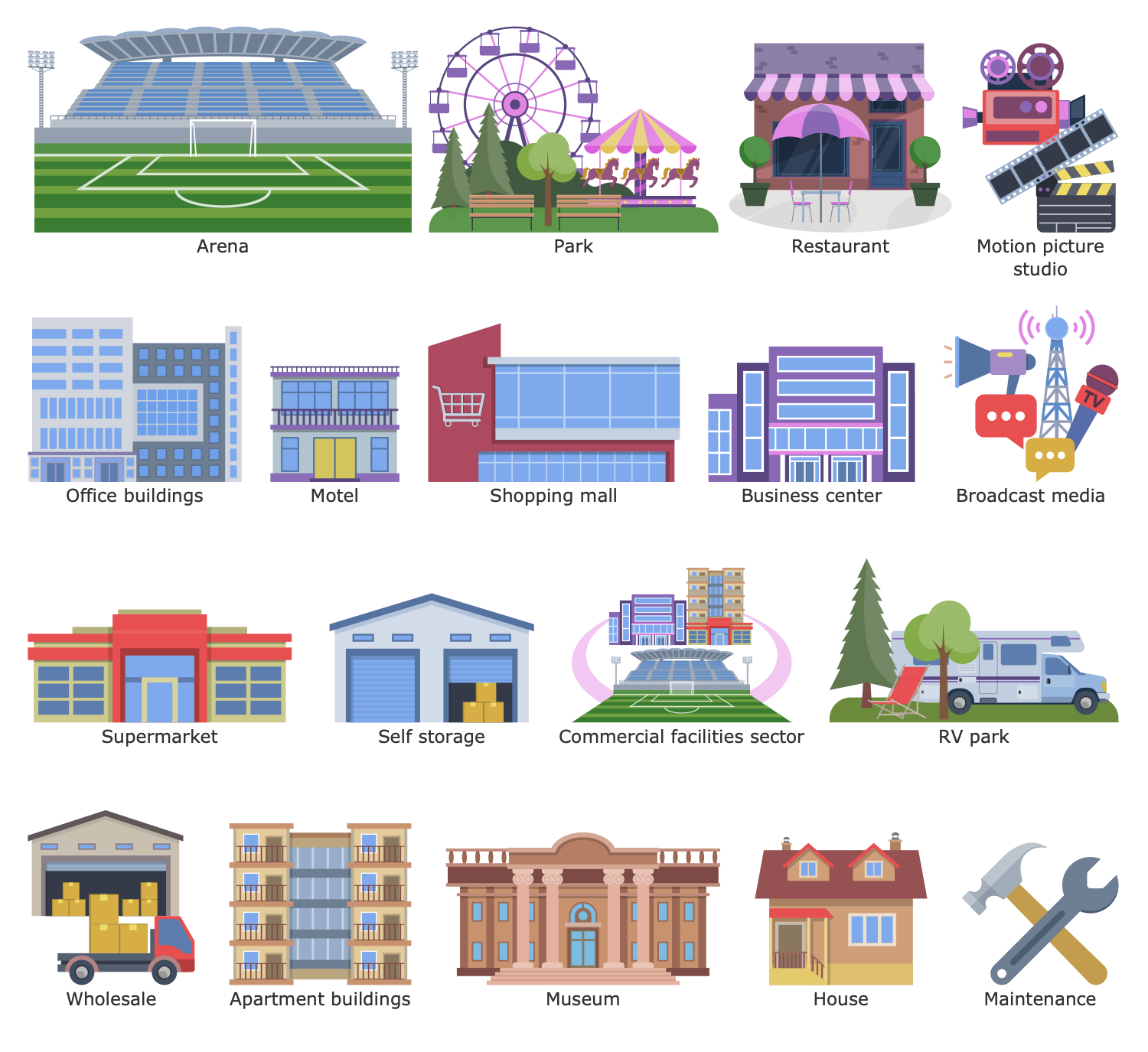
Design Elements — Communications
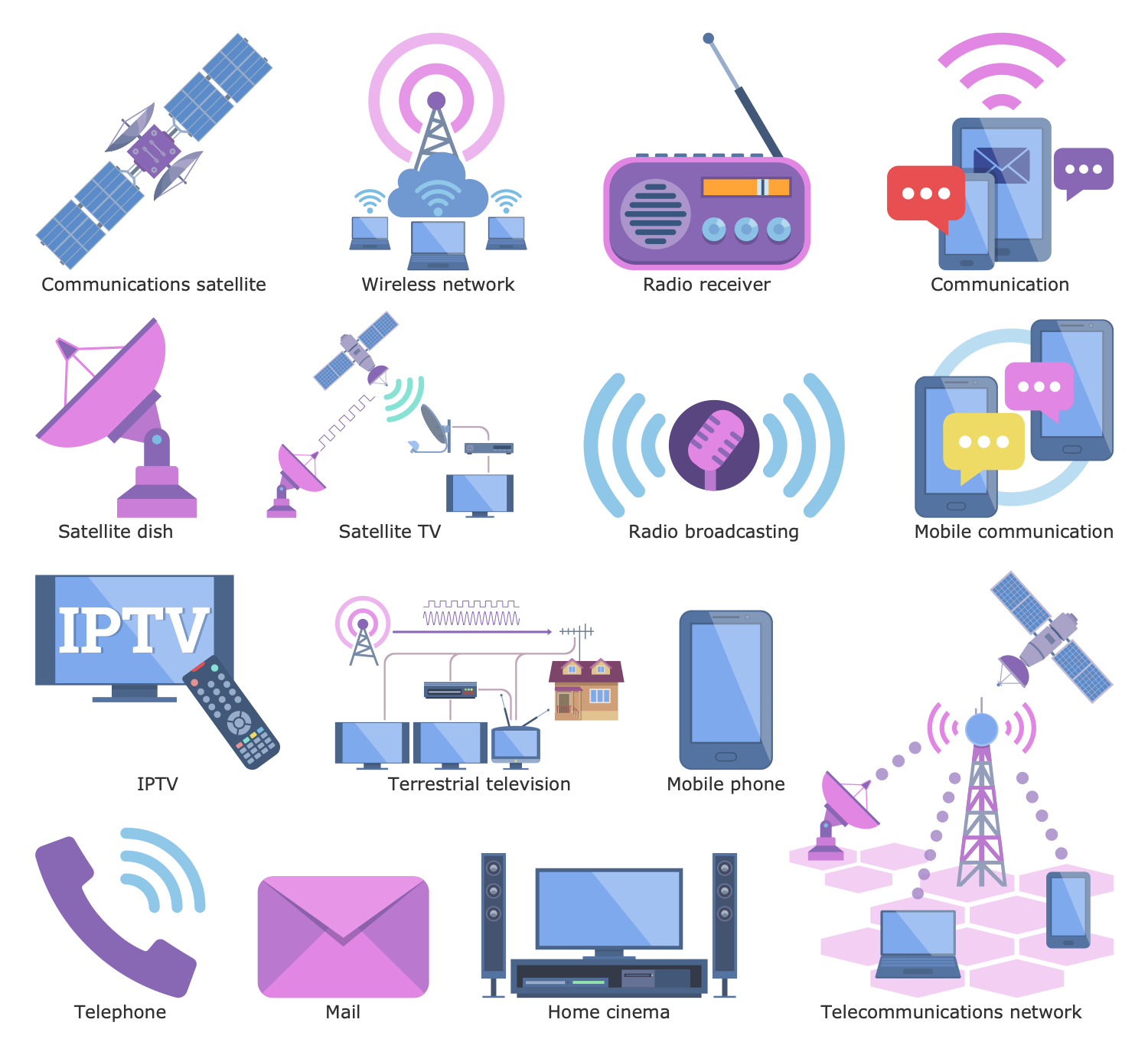
Design Elements — Critical Manufacturing
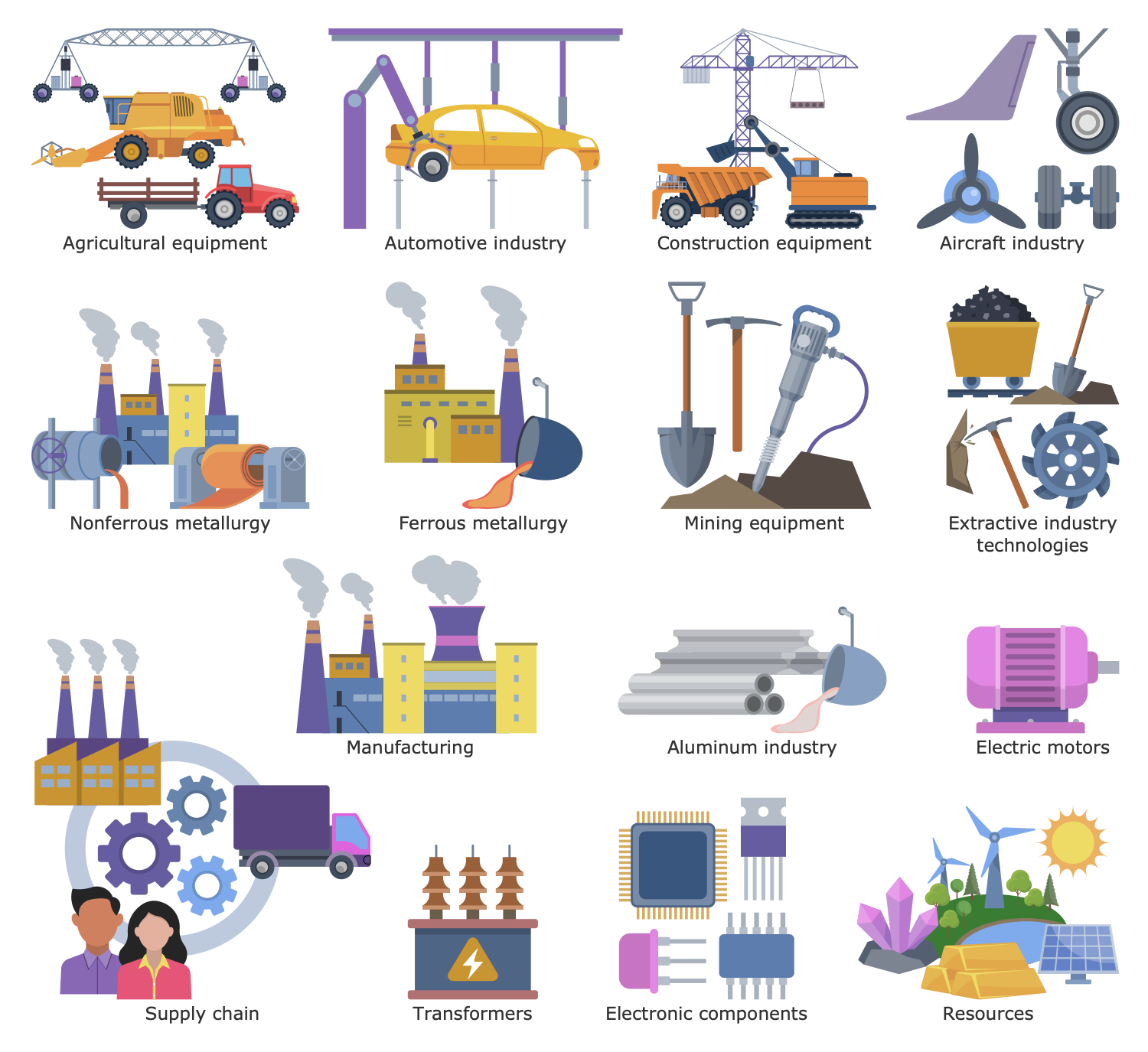
Design Elements — Dams Sector
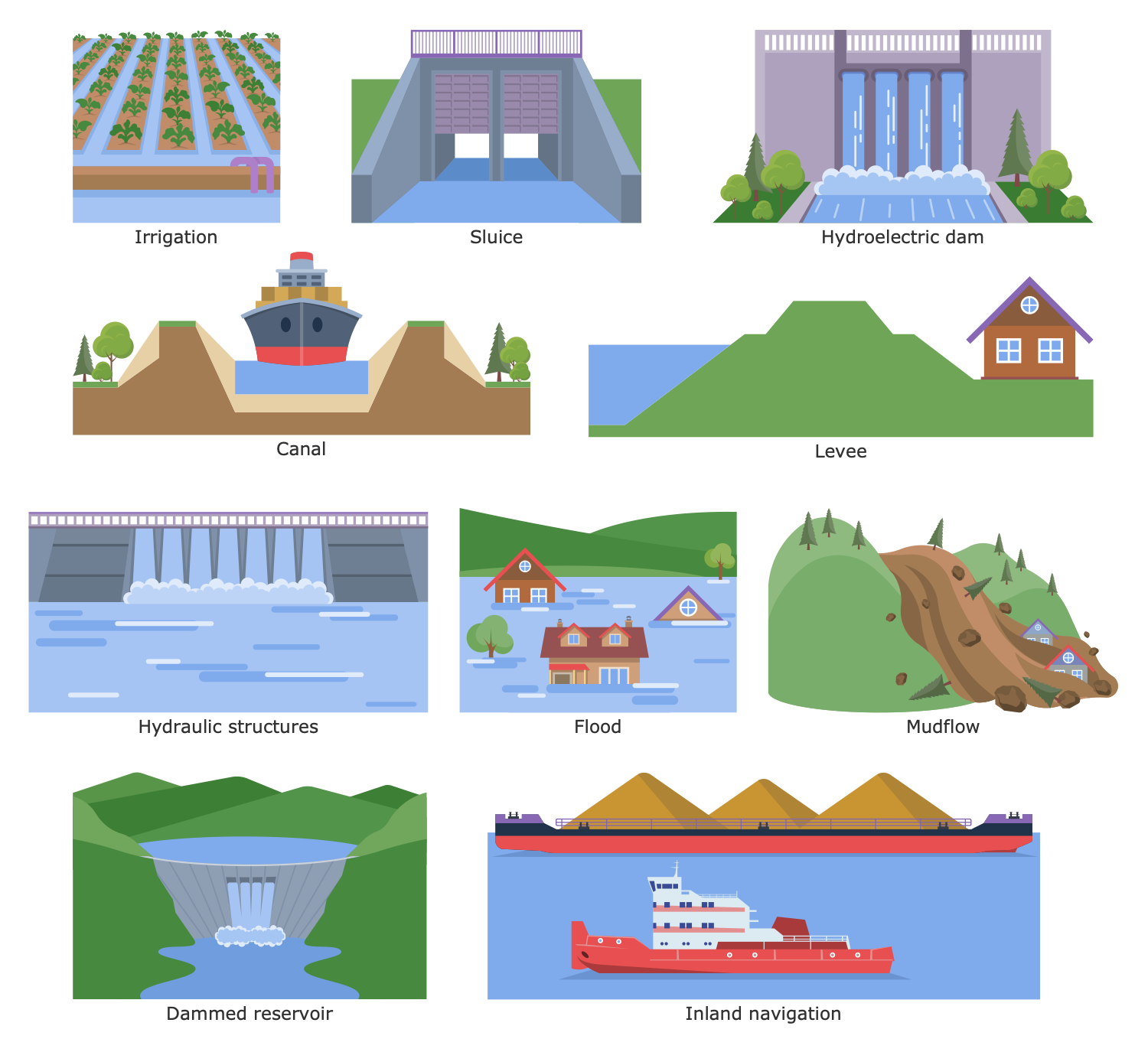
Design Elements — Defense Industrial Base

Design Elements — Emergency Services
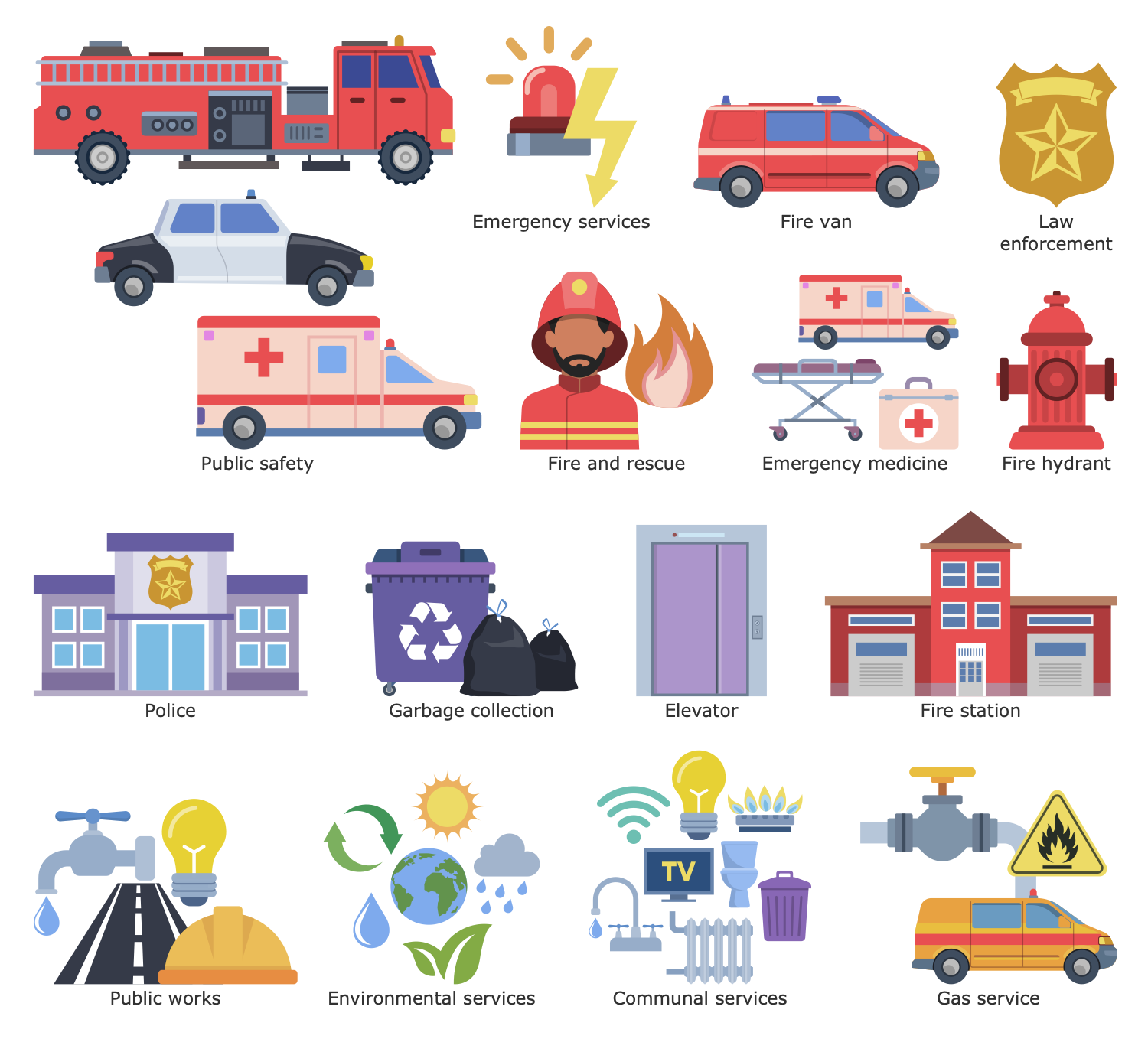
Design Elements — Energy Sector

Design Elements — Financial Services
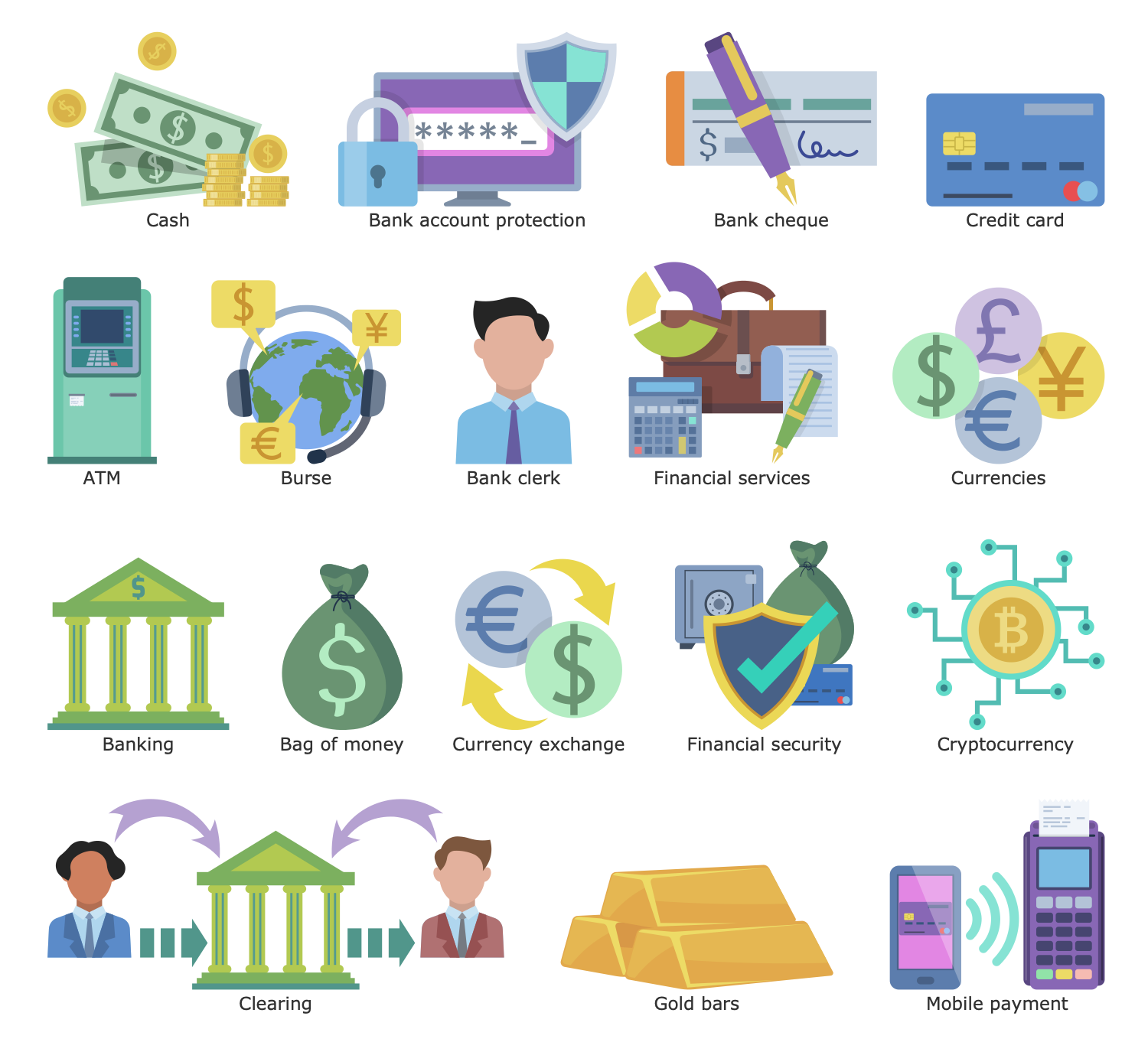
Design Elements — Food and Agriculture Sector
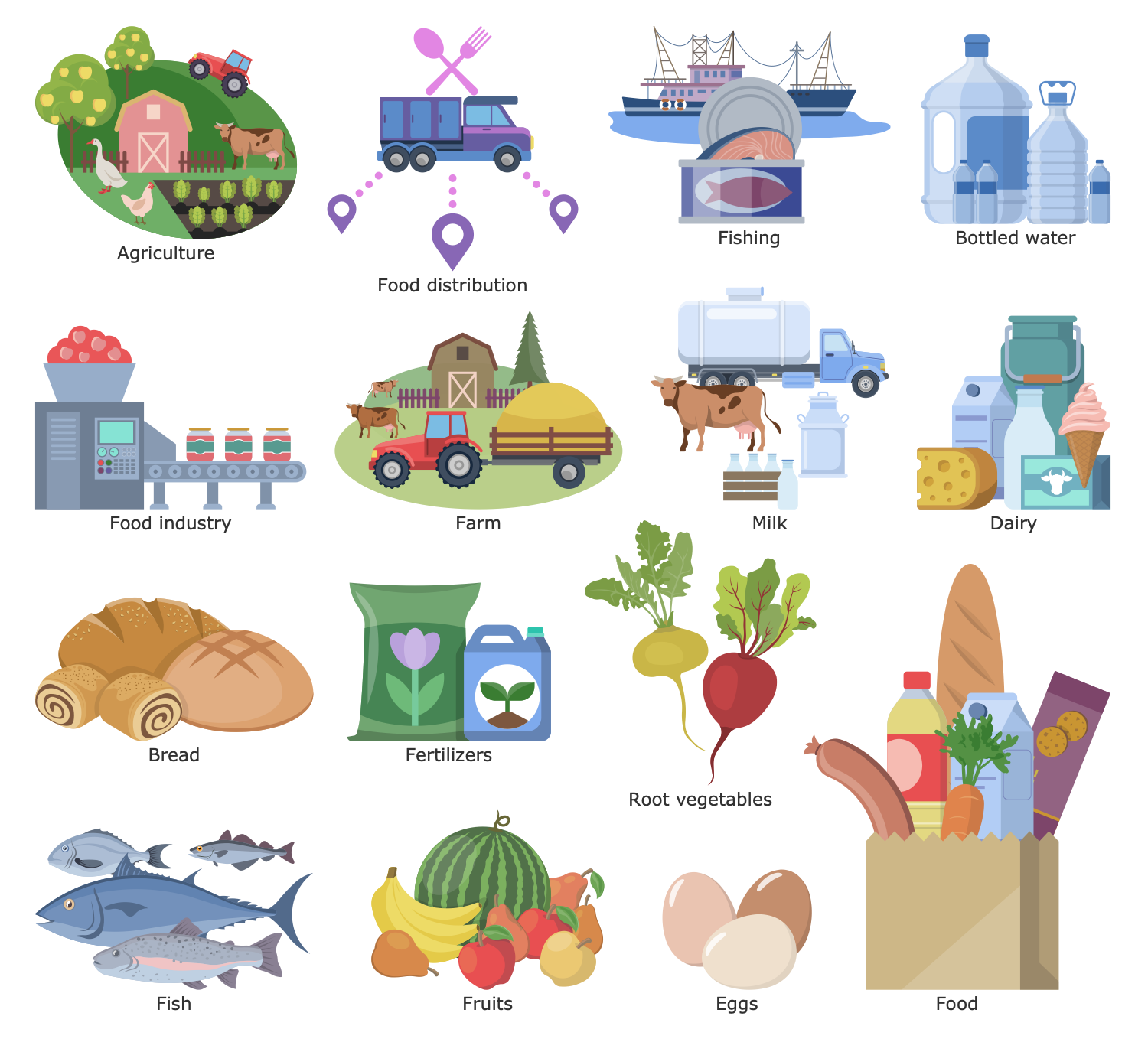
Design Elements — Government Facilities
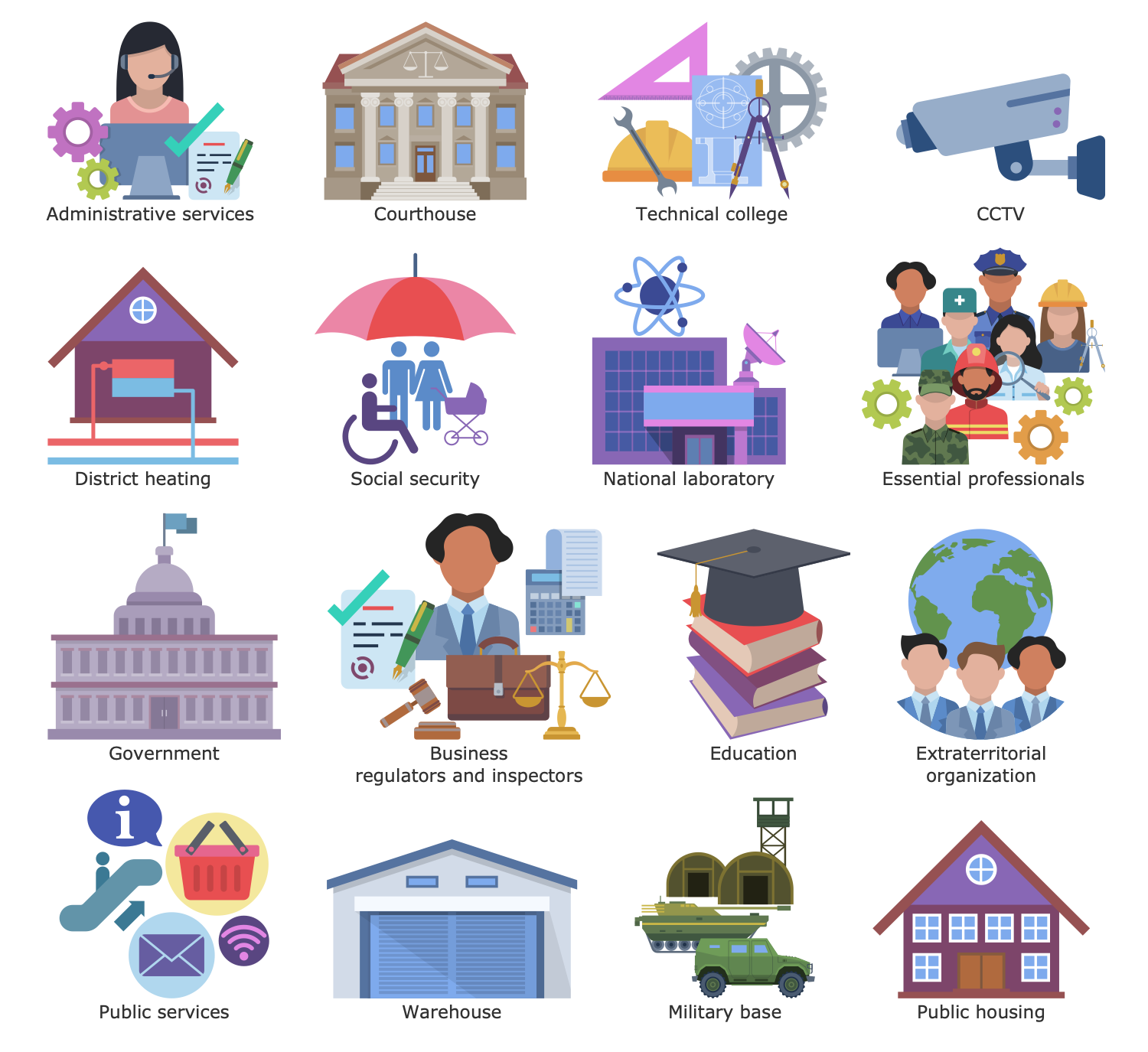
Design Elements — Healthcare Sector

Design Elements — Information Technology Sector
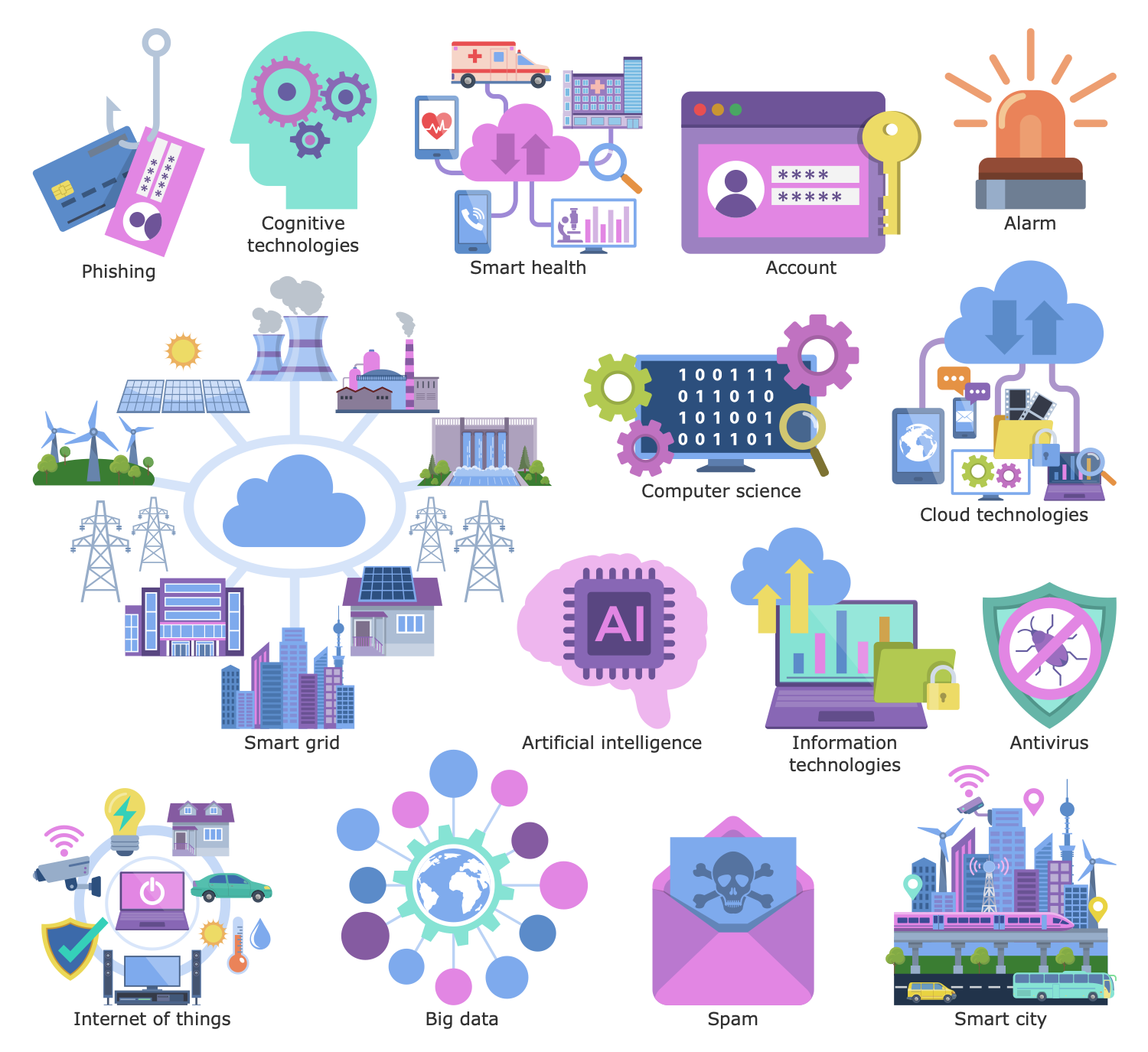
Design Elements — Nuclear Sector
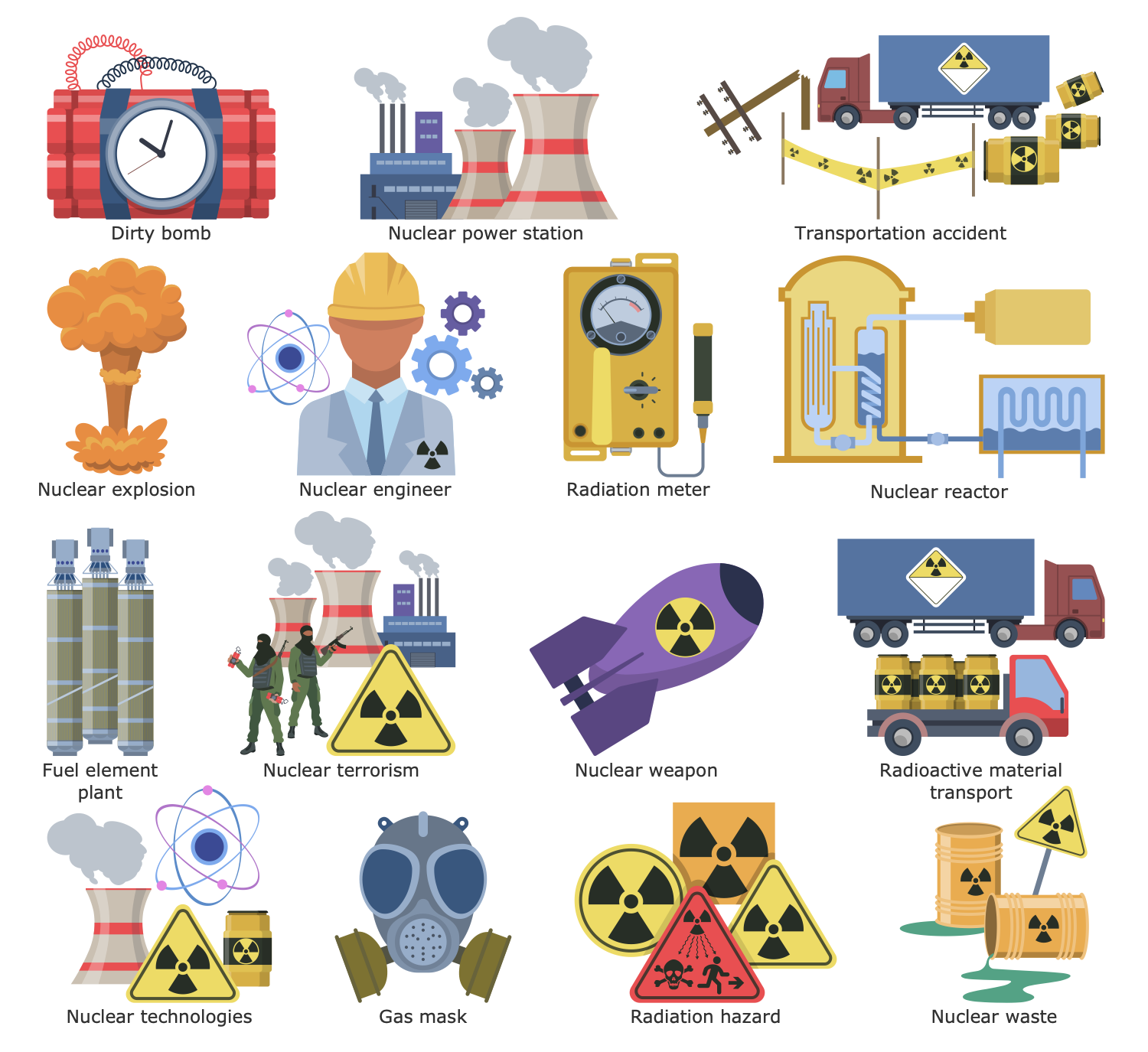
Design Elements — Transportation Systems
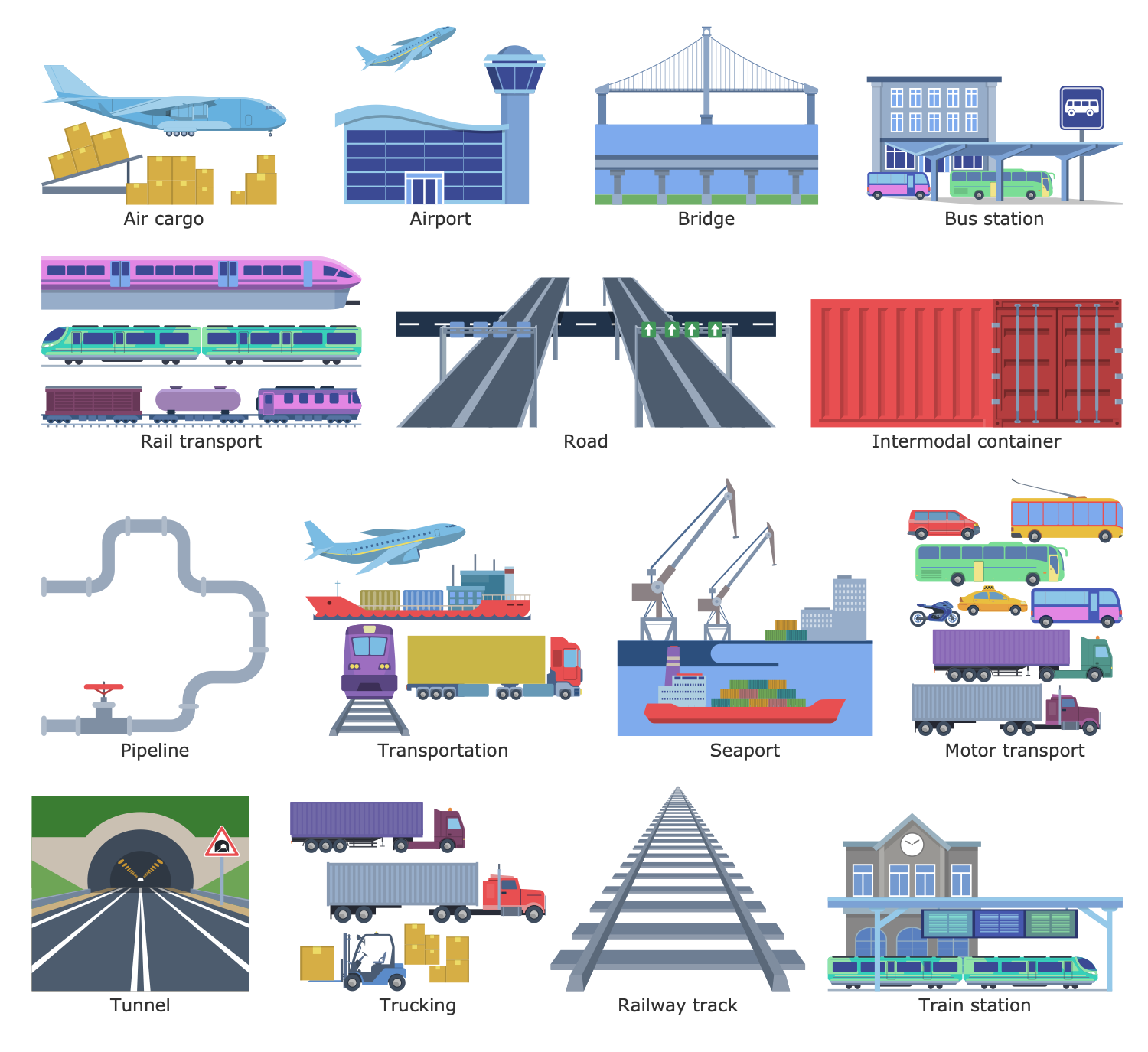
Design Elements — Water and Wastewater
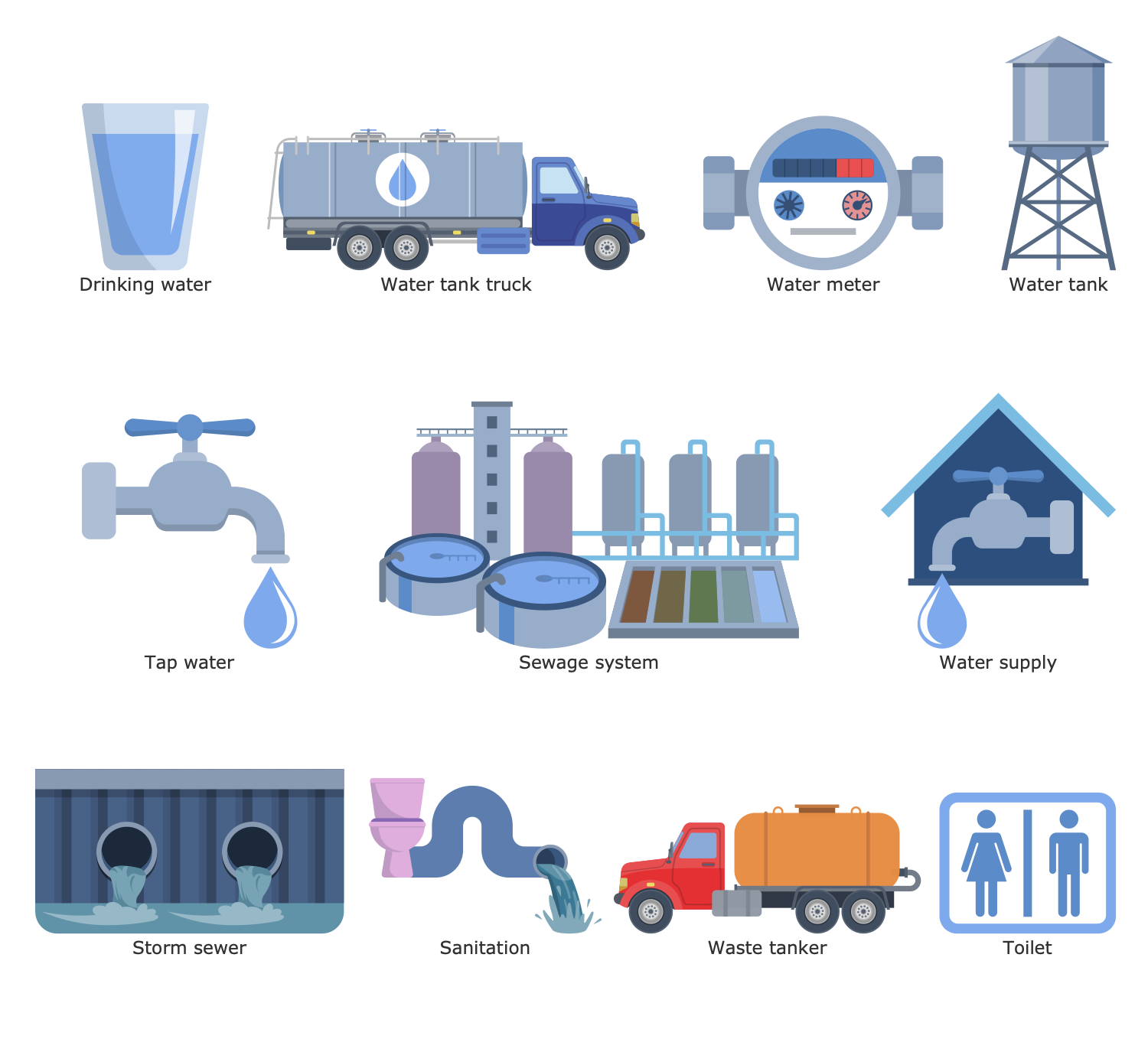
Critical Infrastructure Sectors Examples
There are a few samples that you see on this page which were created in the ConceptDraw DIAGRAM application by using the Critical Infrastructure Sectors solution. Some of the solution's capabilities as well as the professional results which you can achieve are all demonstrated here on this page.
All source documents are vector graphic documents which are always available for modifying, reviewing and/or converting to many different formats, such as MS PowerPoint, PDF file, MS Visio, and many other graphic ones from the ConceptDraw Solution Park or ConceptDraw STORE. The Critical Infrastructure Sectors solutions are available to all ConceptDraw DIAGRAM users to install and use it for working in diagramming and drawing.
Example 1: Critical Information
This diagram was created in ConceptDraw DIAGRAM using a combination of libraries from the Critical Infrastructure Sectors Solution. An experienced user spent 10 minutes creating this sample.
This sample is dedicated to the critical information infrastructure (CII), which is vital to the country and the correct functioning of its critical infrastructure. CII is an informational system that processes, controls, receives, stores, and transmits electronic information. It is operated by government entities at different levels (national, provincial, local) and its incapacity or destruction has a great impact on national security, economic security, and social well-being of citizens, national public health and safety. Critical information infrastructure comprises different infrastructures, information systems, telecommunication networks, automated control systems for technical processes, data centers, digital services, and critical information flows. Any disruptions of these infrastructures can cause harm to people, economics, and country. The CII's protection on the national level is managed by the law of cybersecurity and helps to prevent cybercrimes and the increasing number of cyber-attacks and threats to CIIs, develop a safe and resilient digital ecosystem relative to cybersecurity, ensure confidentiality and integrity, strengthen cybersecurity cooperation among critical sectors, and increase national capacity.
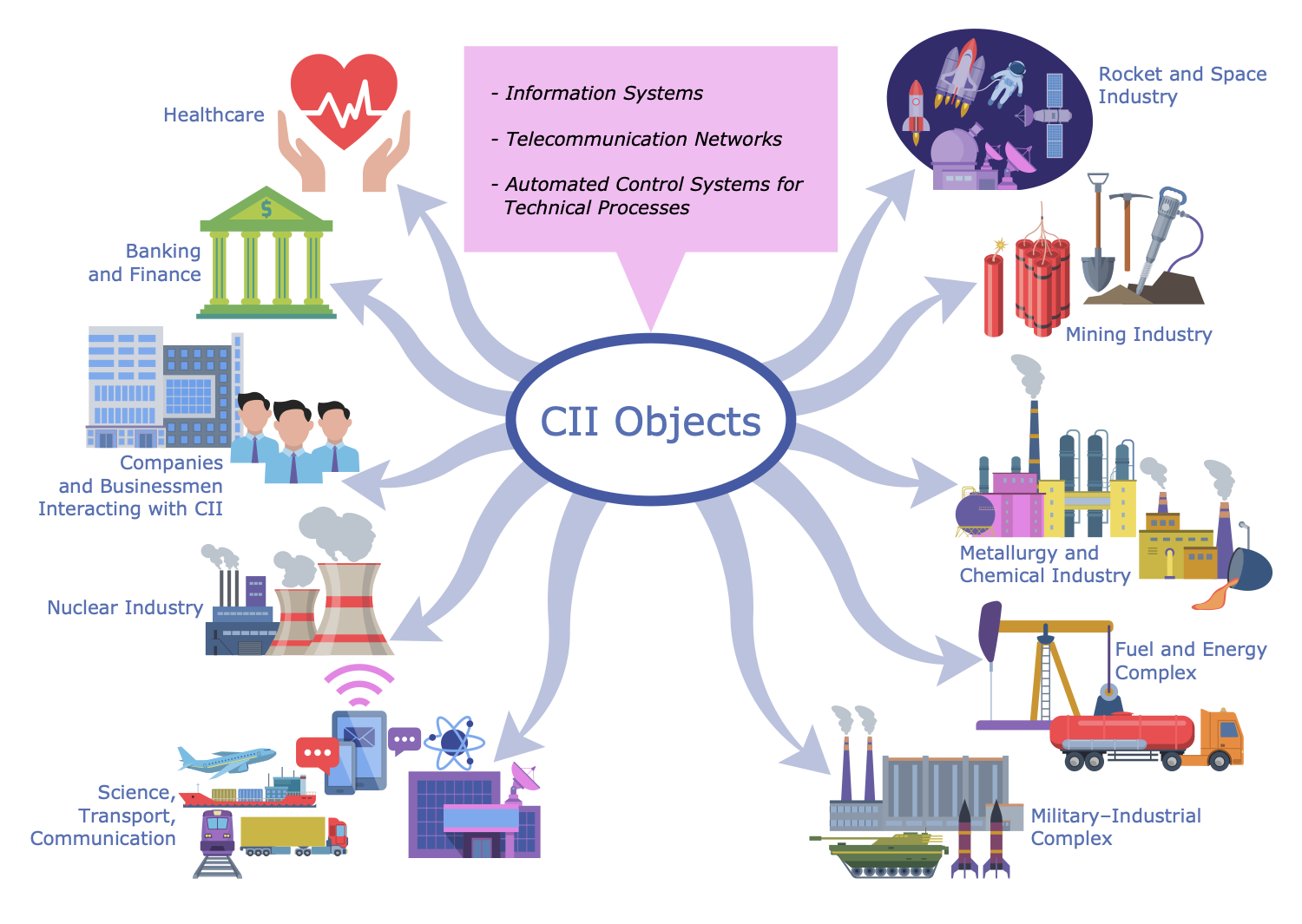
Example 2: Critical Infrastructure Sectors
This diagram was created in ConceptDraw DIAGRAM using a combination of libraries from the Critical Infrastructure Sectors Solution. An experienced user spent 15 minutes creating this sample.
Critical infrastructure comprises infrastructure sectors that are crucial for society and economy functioning. Due to their importance to the country and citizens' well-being, health, and safety, these industries are given special protection by government and internal security agencies. In general, the critical infrastructure includes 16 sectors. However, their list can differ from country to country. This sample shows the main assets and facilities of critical infrastructure. These include the facilities related to electricity generation, water supply, public health, transportation systems, security services, food, transmission and distribution, renewable energy, telecommunication, economic sector, shelter and heating, and education. The most important sectors are considered to be electricity generation, water supply and healthcare. Most electricity is generated from natural gas, coal, fuel oil, and nuclear power. However, renewable energy from sunlight, wind, rain, tides, waves, geothermal heat gains more and more popularity today. Water supply includes drinking water, wastewater and sewage, and surface water drainage. Hospitals and ambulances are the main public health facilities. At the same time, other sectors are not less important. Specific government departments are responsible for each sector of critical infrastructure and its uninterrupted operation.
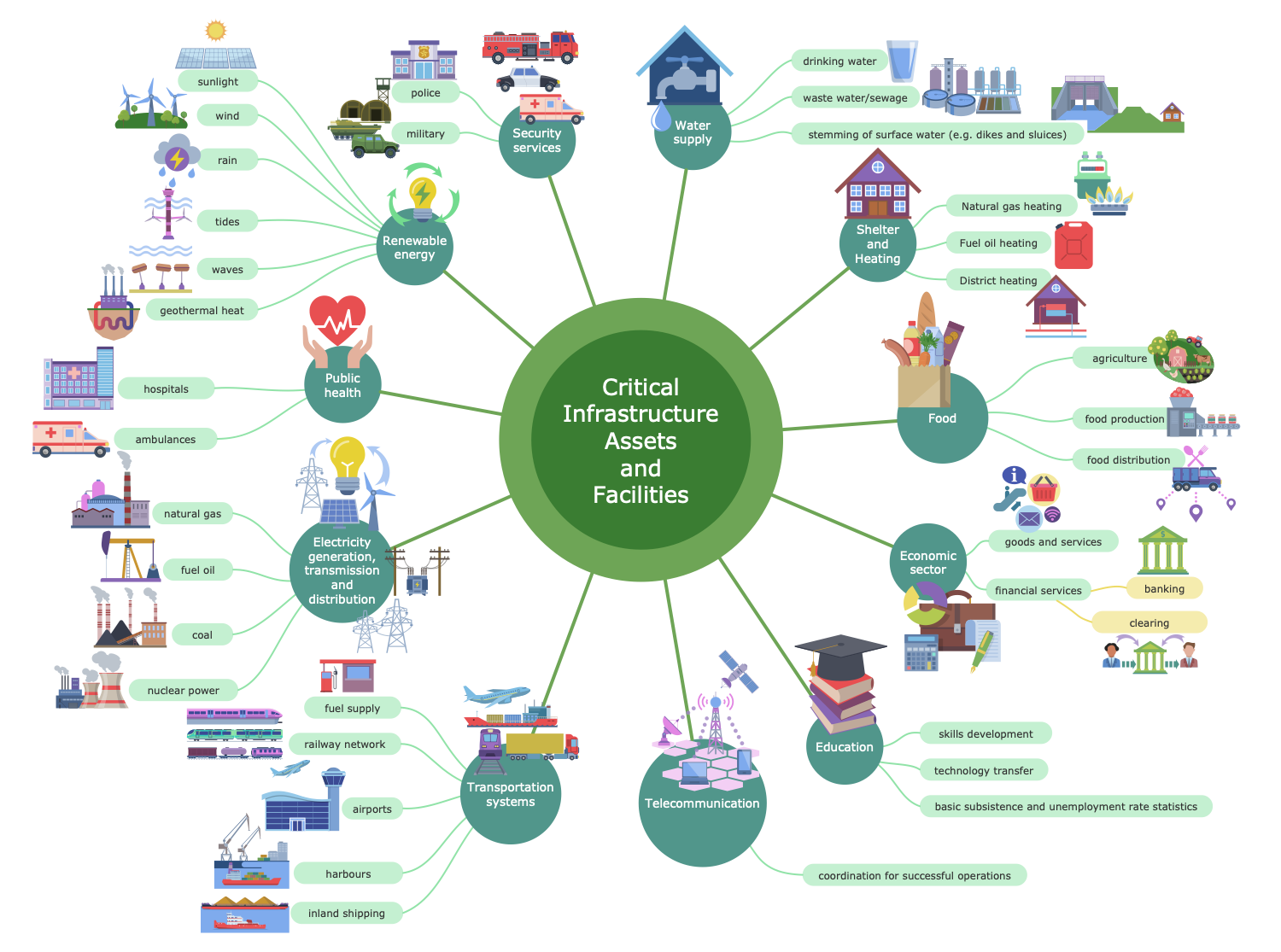
Example 3: Defense Industrial Base
This diagram was created in ConceptDraw DIAGRAM using a combination of libraries from the Critical Infrastructure Sectors Solution. An experienced user spent 20 minutes creating this sample.
Defense industrial base (DIB) includes the governmental industrial assets involved in the production of equipment for a country's armed forces, the Department of Defense, and other federal departments and agencies. It can include hundreds of thousands of domestic and foreign entities and subcontractors that research, design, develop, produce, test, deliver, and maintain military weapons systems and subsystems, their components and parts, defense-related products and services. The defense-related systems and equipment developed by the DIB sector are used to equip defense forces, mobilize, deploy, sustain, and inform the military during the operations worldwide. This sample shows the subsectors and segments of the defense industrial base sector. The list includes 15 subsectors: shipbuilding industry, aircraft industry, missile industry, space industry, combat vehicle industry, ammunition industry, weapons industry, troop support industry, information technology industry, electronics industry, electrical industry commodities, electronics industry commodities, mechanical industry commodities, structural industry commodities, research and development facilities. Numerous segments belong to each DIB sector and are listed in the diagram.

Example 4: Economic Activities ISIC
This diagram was created in ConceptDraw DIAGRAM using a combination of libraries from the Critical Infrastructure Sectors Solution. An experienced user spent 15 minutes creating this sample.
This sample shows the International Standard Industrial Classification of All Economic Activities (ISIC). Each activity is defined by the type of production in which it is engaged. ISIC is an international industry classification system intended by the United Nations, maintained by its Statistics Division, and recommended for use by all member-states of the UN and adoption as a national standard. ISIC is aptly applied to collect, classify, and report data according to the economic activities in the fields of employment, statistics, economic analysis, healthcare, administrative and non-statistical purposes. ISIC classifies entities by activity, helps to organize information about the economics state according to economic principles and perceptions. This classification structure of economic and productive activities is based on a set of internationally accepted principles, concepts, definitions, and classification rules. The main economic activities include agriculture, forestry and fishing, mining and quarrying, manufacturing, water supply, sewerage, waste management and remediation activities, power supply, gas supply, construction, transportation and storage, financial and insurance activities, human health and social work activities, education, public administration and defense, information and communication, wholesale and retail trade, and many others.

Example 5: Electrical Grid
This diagram was created in ConceptDraw DIAGRAM using a combination of libraries from the Critical Infrastructure Sectors Solution. An experienced user spent 15 minutes creating this sample.
This sample shows a structure of the electrical grid, which is a network of interconnected power lines and dedicated infrastructure that delivers electricity from power plants to factories, businesses, homes, and other facilities. The transmission and distribution lines are operated by control centers and ensure the synchronized power supply from providers to consumers. Electrical grids vary in size and quantity of equipment. Usually they cover large areas; the scale can reach an entire country or even a continent. Major facilities include power plants, electrical substations, power transmission and distribution equipment. Power plants produce extra high voltage electricity and are often located far from densely populated areas, close to energy sources. Electrical substations step down the voltage to high voltage, which is supplied to large and medium-sized plants and factories. Power lines transmit electricity over long distances. It is then supplied to individual consumers via power lines where the voltage is reduced to a low operating voltage. Low voltage electricity, ready for distribution to end consumers, is also produced by solar, wind and municipal power plants.
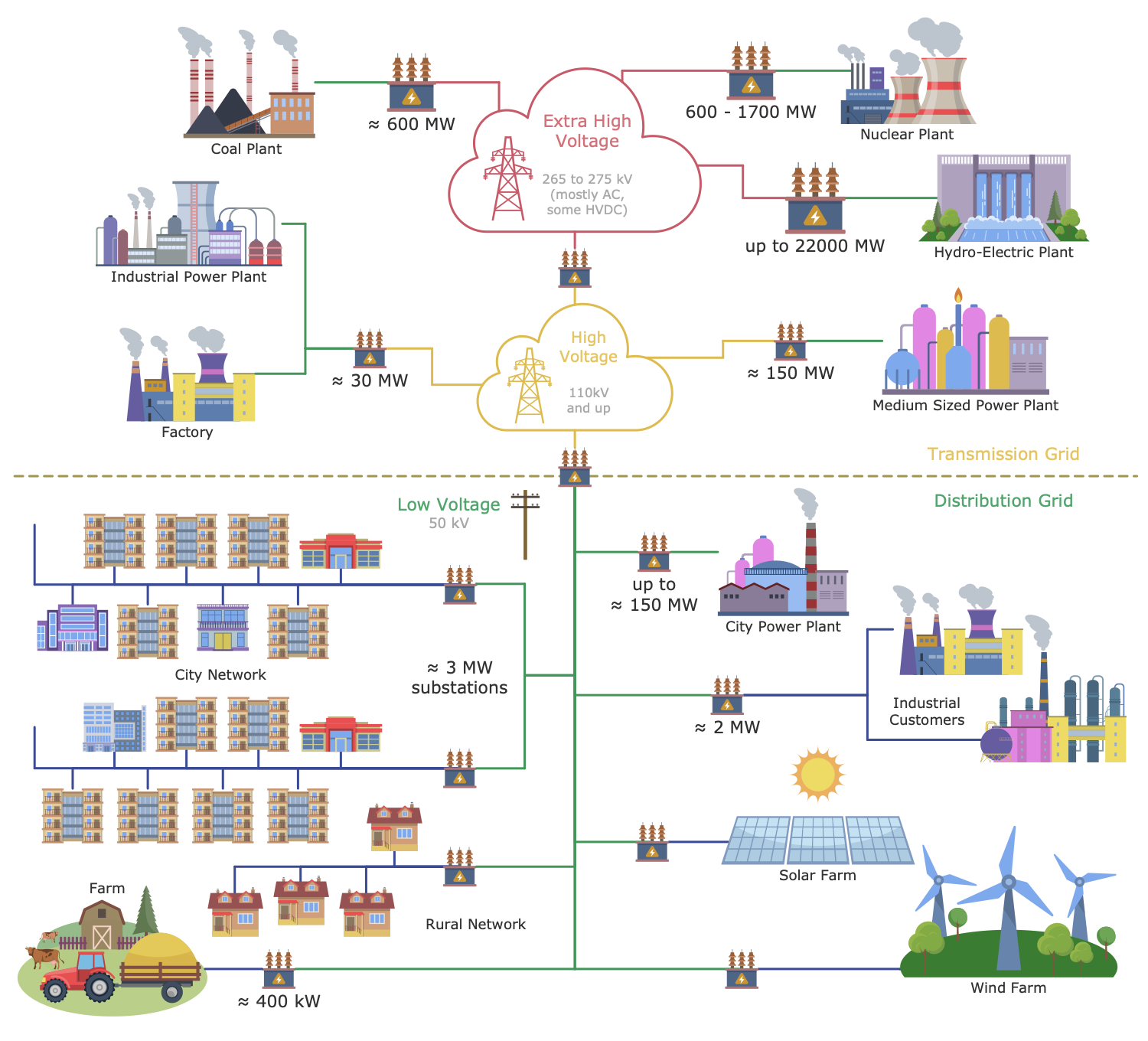
Example 6: Emergency Services
This diagram was created in ConceptDraw DIAGRAM using a combination of libraries from the Critical Infrastructure Sectors Solution. An experienced user spent 5 minutes creating this sample.
This sample highlights the key areas of the emergency services (ESS) sector: law enforcement, public works, fire and rescue, emergency medical services, and emergency management. The emergency services sector includes physical and cyber resources, organizations and highly skilled trained personnel dedicated to public safety, security and health, incident prevention, preparedness, rapid response and recovery during routine and emergency operations considering and resolving various emergency situations. It includes personnel and equipment at different levels: federal, state, local, and territorial. These include various first responders, police departments, fire departments, rescue services, emergency medical services, emergency management, law enforcement, and city public works departments. This also includes private sector resources: industrial fire services, private ambulance services, private security organizations, etc. Facilities are geographically distributed and have dedicated transportation. ESS frequently provides emergency awareness and prevention programs to educate the public to avoid, detect, and promptly report emergency situations.

Example 7: Essential Services
This diagram was created in ConceptDraw DIAGRAM using a combination of libraries from the Critical Infrastructure Sectors Solution. An experienced user spent 15 minutes creating this sample.
This sample lists essential services that are vital daily services for the basic functioning of society, the preservation of human health and life, public safety and the well-being of the population. In any case, they remain important to the service. Moreover, a key characteristic of essential services is their ability to ensure continuity of service during emergencies, natural disasters and any other incidents. Industries defined as essential services can differ from country to country and are defined by the country's Ministry of Security. Usually, they include healthcare, public health, public safety, human services, energy, water and wastewater, food and agriculture, transportation and logistics, law enforcement, first responders, public works, communications and information technology, critical manufacturing, supply chains, retail and wholesaling, food services and accommodations, institutional, residential, commercial, and industrial maintenance, manufacturing and production, construction, financial activities, resources, environmental services, utilities and community services, communications industries, research, justice, business regulators and inspectors, and other community-based essential functions and government operations.
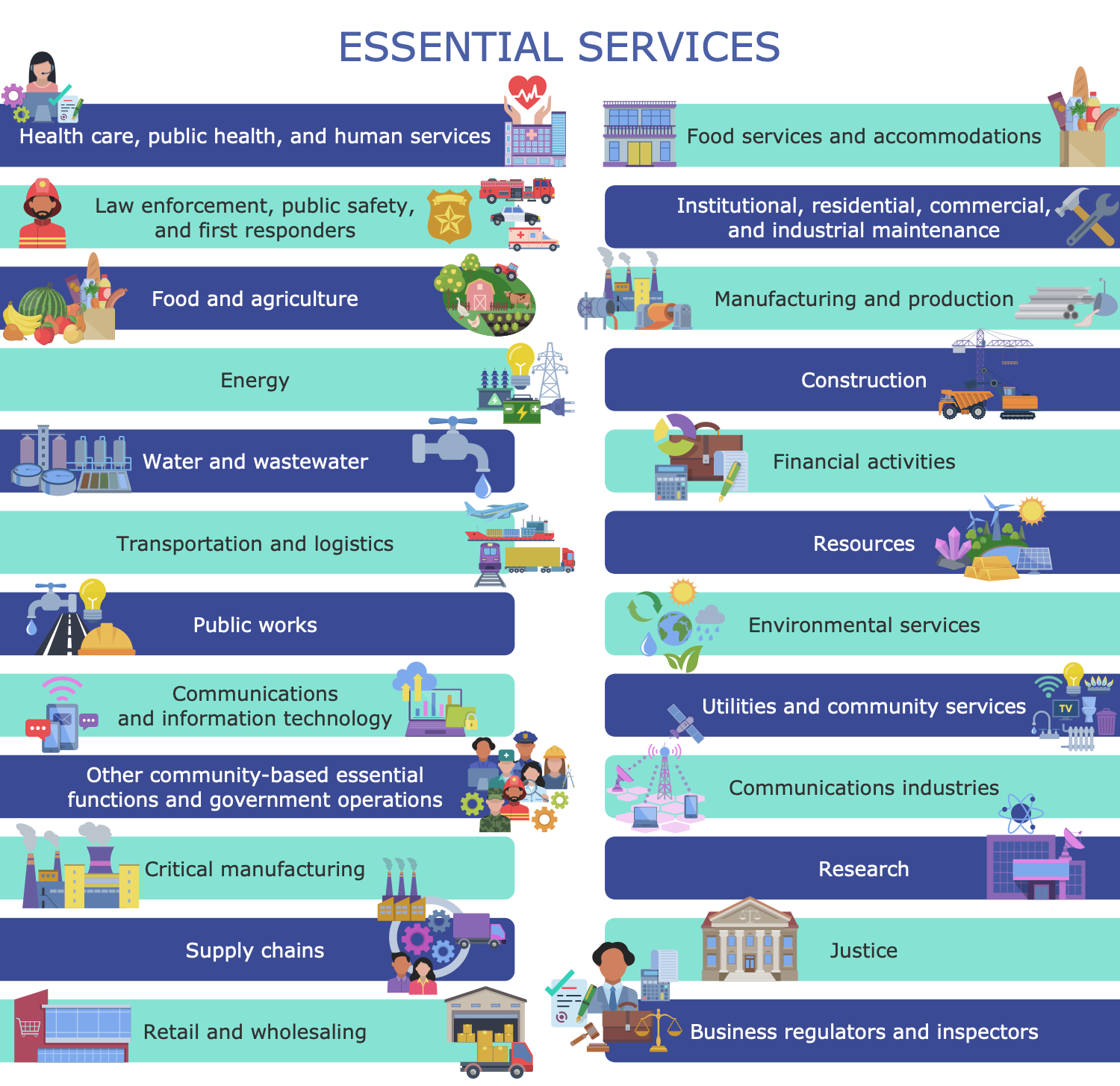
Example 8: Fertilizers Supply Chain
This diagram was created in ConceptDraw DIAGRAM using a combination of libraries from the Critical Infrastructure Sectors Solution. An experienced user spent 10 minutes creating this sample.
This sample illustrates the fertilizer supply chain from source to farm. Intermediate stages include pipeline and transport infrastructure, processing plant, distribution or wholesale and farm supply, from where the fertilizer is delivered to the end user. The disruptions at any stage of this supply chain can impact the global food supply chain and put it at risk. Because fertilizers are an important substance for obtaining high yields in agriculture. They are added to soil or plant tissue to provide additional nutrients to plants, improve soil fertility and increase plant productivity. Fertilizers can be of various origins, natural or synthetic, industrial production. Fertilizer application methods also vary; they are applied in dry powder or granular form, or in liquid form using special agricultural equipment or by hand. Essential soil nutrients include nitrogen, phosphorus and potassium, which form the basis of many modern fertilizers. The field is constantly evolving in an effort to provide farmers with inexpensive, sustainable and effective fertilizers.
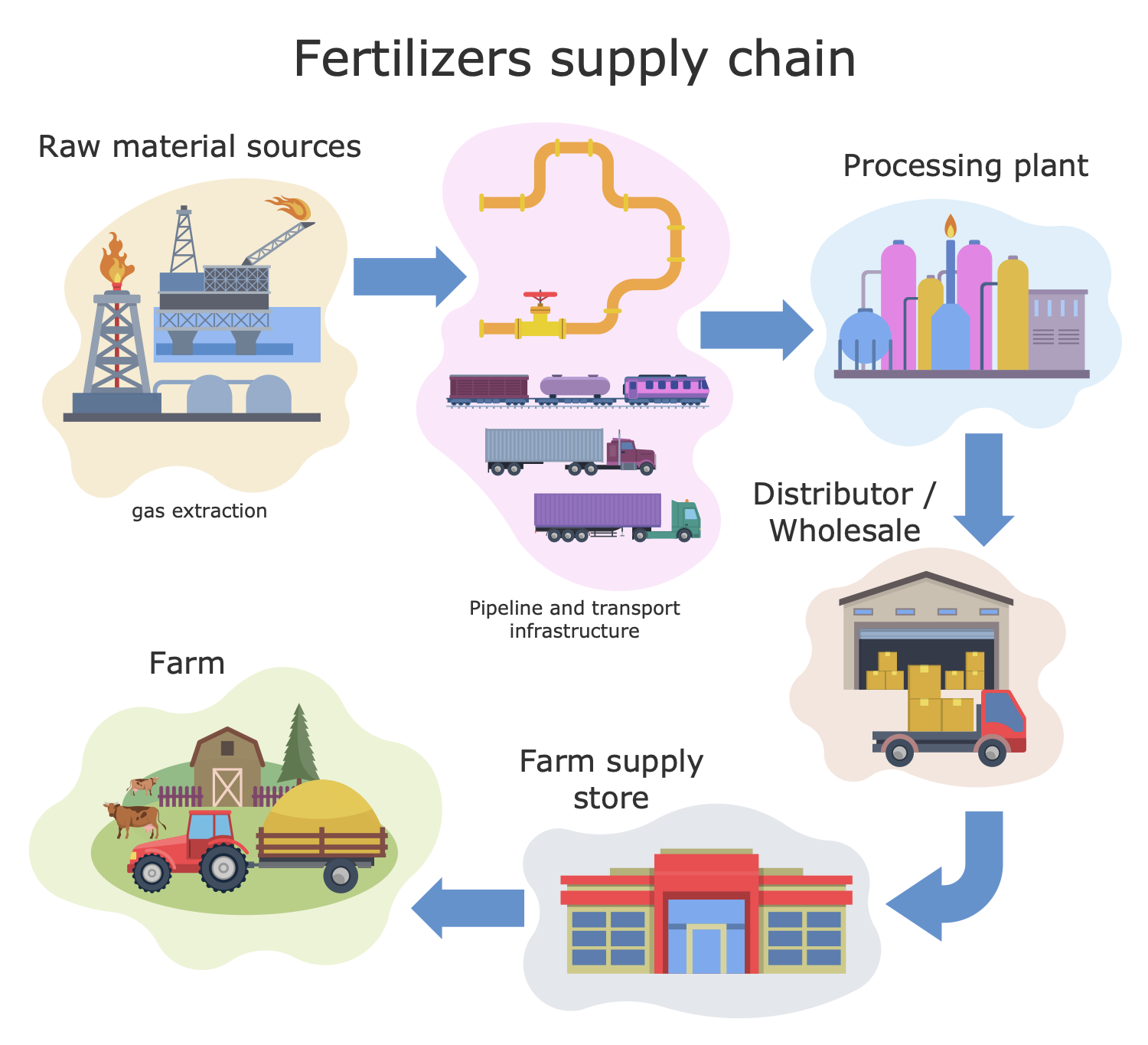
Example 9: Food Supply Chain
This diagram was created in ConceptDraw DIAGRAM using a combination of libraries from the Critical Infrastructure Sectors Solution. An experienced user spent 10 minutes creating this sample.
This sample shows the food supply chain, which is the sequence of processes and entities through which all food products pass, from agriculture to the final consumers, including both individual customers and food service providers. Transfer from one point to another is carried out through transport and logistics. On the supply way, food passes the raw materials storage facilities, food processing, manufacturing, and packaging enterprises, distribution and retail facilities. Source raw materials are purchased from smallholder farmers and large agriculture enterprises and are transferred to the corresponding manufacturing enterprises where are processed into different kinds of food. Being produced and packed, food products are ready to be distributed to the warehouses and distribution centers and then to retail facilities. A reliable and well-managed food supply chain is essential to produce safe food products that correspond to high-quality requirements and consumer demand and gives the possibility to consumers to trace the origin of food. Because the complex and multi-stepped food supply chains including the import of raw materials from long-distance corners of the world often make it difficult for consumers to trace the origin of purchased food and how it was produced.
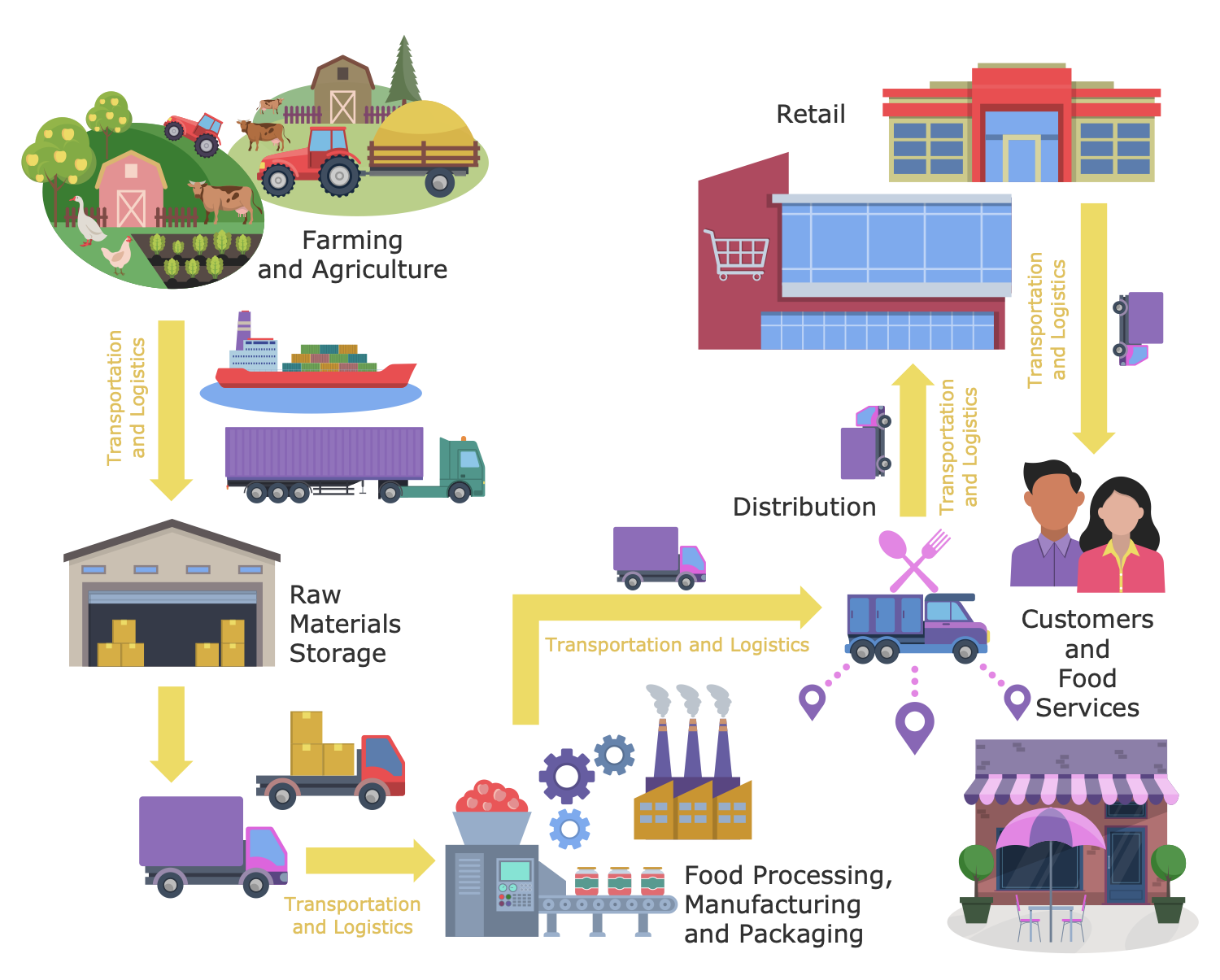
Example 10: IT Sector
This diagram was created in ConceptDraw DIAGRAM using a combination of libraries from the Critical Infrastructure Sectors Solution. An experienced user spent 15 minutes creating this sample.
This sample illustrates the information technology sector, which is a part of the economy and performs a wide set of functions. IT sector has great value to the nation's security, public health and safety, government, businesses, banking system, private citizens, etc. It comprises computers and other electronics, hardware, and peripheral equipment, software, information technology systems, services, programming languages, data and information processing and storage, social media, companies that produce software and hardware equipment, companies that provide internet and related services, online databases, interactive services, and other tools. IT sector is connected to almost all fields of modern life and activity. The list of major sectors related to IT includes the energy sector, financial services sector, chemical sector, commercial facilities sector, communications sector, critical manufacturing sector, dams sector, defense industrial base sector, emergency services sector, food and agriculture sector, transportation systems sector, water and wastewater systems sector, government facilities sector, healthcare and public health sector, nuclear reactors, materials, and waste sector.
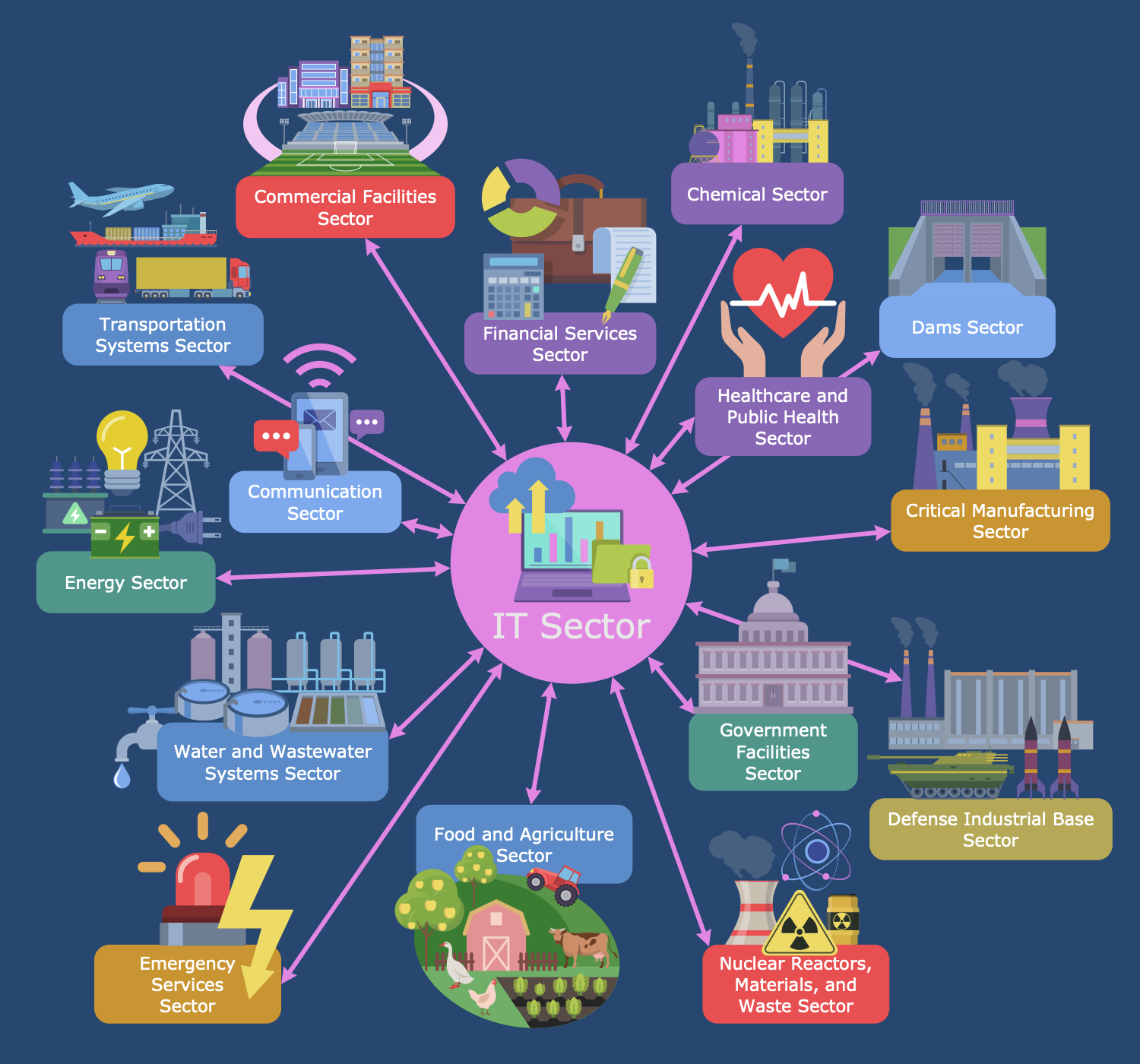
Example 11: Most Critical Industries
This diagram was created in ConceptDraw DIAGRAM using a combination of libraries from the Critical Infrastructure Sectors Solution. An experienced user spent 10 minutes creating this sample.
This sample shows the top seven of the most critical industries in the world. These include utilities, mass transit (air and rail), telecommunications, defense, oil and gas production, cloud and colocation services, and smart cities. The ranking was performed according to the defined set of criteria. These industries were defined based on evaluating the scope and severity of the impact of disruptions or downtime in that industry. The services, facilities, systems, and assets essential for national economic security and the proper functioning of society, its well-being, health, and safety belong to critical infrastructure and critical industries. The smooth running of infrastructure and its security is important to the government and all citizens without exception. At the same time, criticality is subjective and dependent on the situation and other factors, and it is impossible to select the most critical from others. Sometimes criticality can increase as the industry grows, develops and evolves. The list of critical industries may also change depending on the priorities of the country and government.
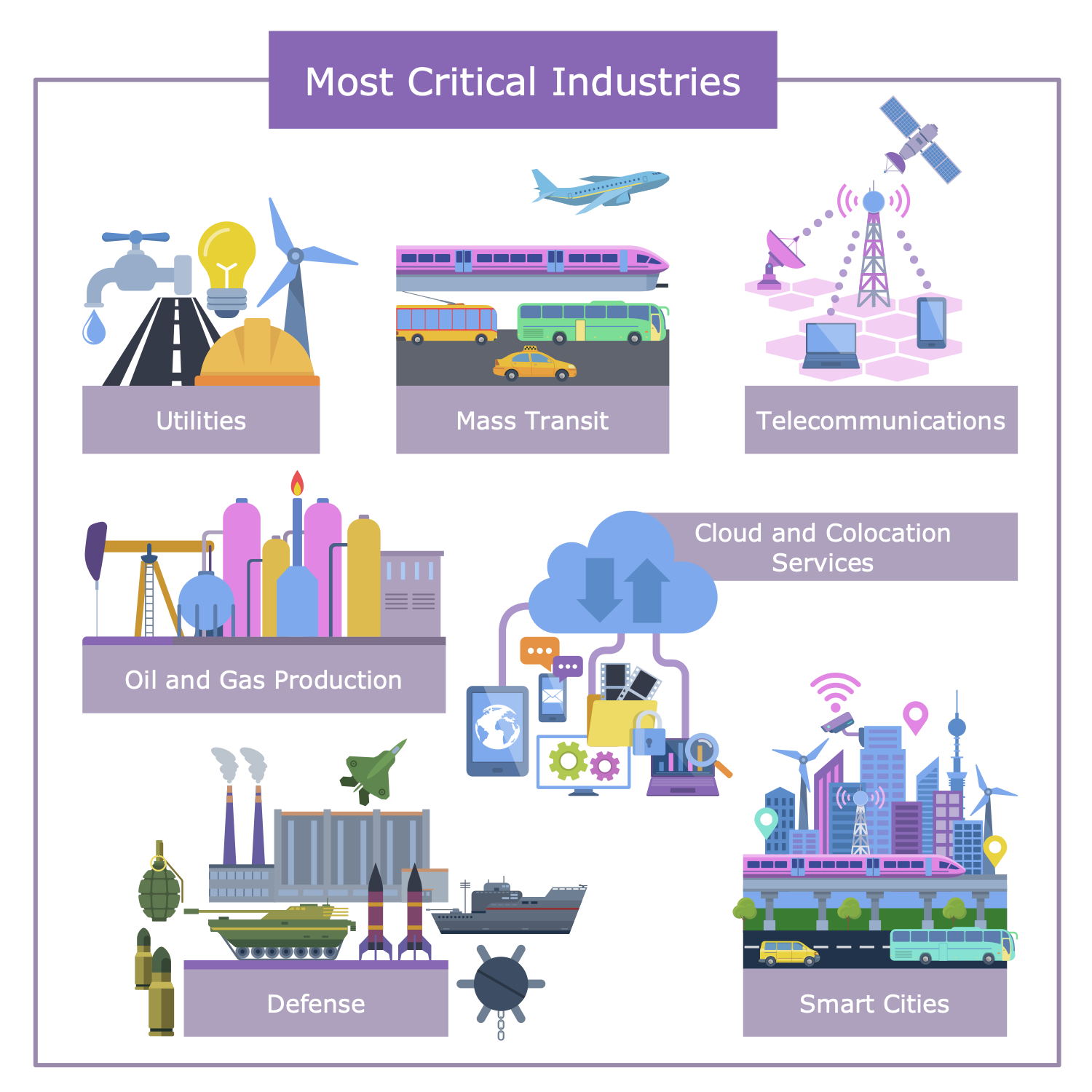
Example 12: Oil and Gas Infrastructure
This diagram was created in ConceptDraw DIAGRAM using a combination of libraries from the Critical Infrastructure Sectors Solution. An experienced user spent 10 minutes creating this sample.
This sample shows the infrastructure of the oil and gas industry, which produces large volumes of products: fuel oil, petrol, chemical products, fertilizers, synthetic fragrances, pharmaceuticals, solvents, plastics, etc. The oil and gas industry is divided into three major sectors on the way of petroleum and oil products to the end consumer. These include upstream, midstream, and downstream sectors. The upstream sector comprises the exploration of underground and underwater crude oil and natural gas fields, their development, drilling the exploratory wells, operating the wells to bring the crude oil and raw natural gas to the surface, and other production operations. The midstream sector contains transportation by pipelines, railroads, barges, trucks, or tankers from production sites to refineries, from natural gas purification plants to downstream customers. It also includes storage, processing, distribution, and wholesale marketing of both crude and refined petroleum products to downstream distributors. The downstream sector includes manufacturing, processing, and refining petroleum crude oil, purifying raw natural gas, marketing, wholesale, and distribution of numerous petrochemicals, natural gas, and liquefied petroleum gas.
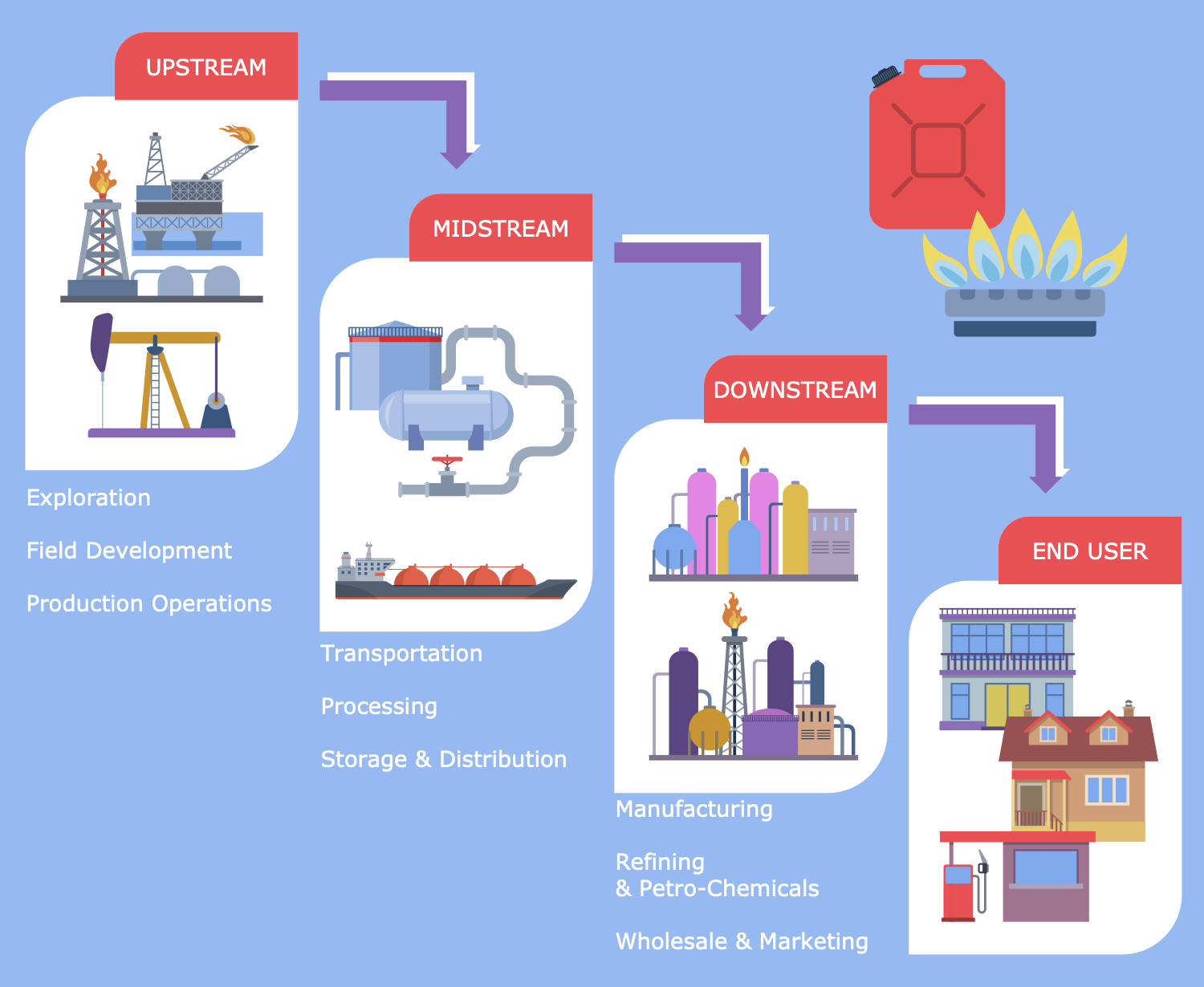
Example 13: Smart City Infrastructure
This diagram was created in ConceptDraw DIAGRAM using a combination of libraries from the Critical Infrastructure Sectors Solution. An experienced user spent 15 minutes creating this sample.
This sample shows the infrastructure of a smart city that is built by introducing modern technologies, methods, information systems, newest electronic equipment, and sensors, which collect data and information in order to automate the different sectors of the city. The collected data are then processed and analyzed to monitor and manage the activities in the smart city, trace assets and resources, and deliver the best services to inhabitants. Sharing data between different systems and sectors contributes to the improvement of coordination the operations across the city, enhancing quality, performance, and interactivity of urban services, growing reliability and understanding, achieving economic benefits, reducing costs and resource consumption. It helps to optimize the efficiency of city operations and services, and increase communication between citizens and government. Smart technologies are introduced in all sectors and smart city possesses smart energy, smart buildings, smart traffic and transportation systems, smart manufacturing, smart healthcare and hospitals, public safety and security systems, open data, mobility and WiFi, waste management, smart water supply networks, power plants and utilities, education facilities, community services, and is governed by smart government.
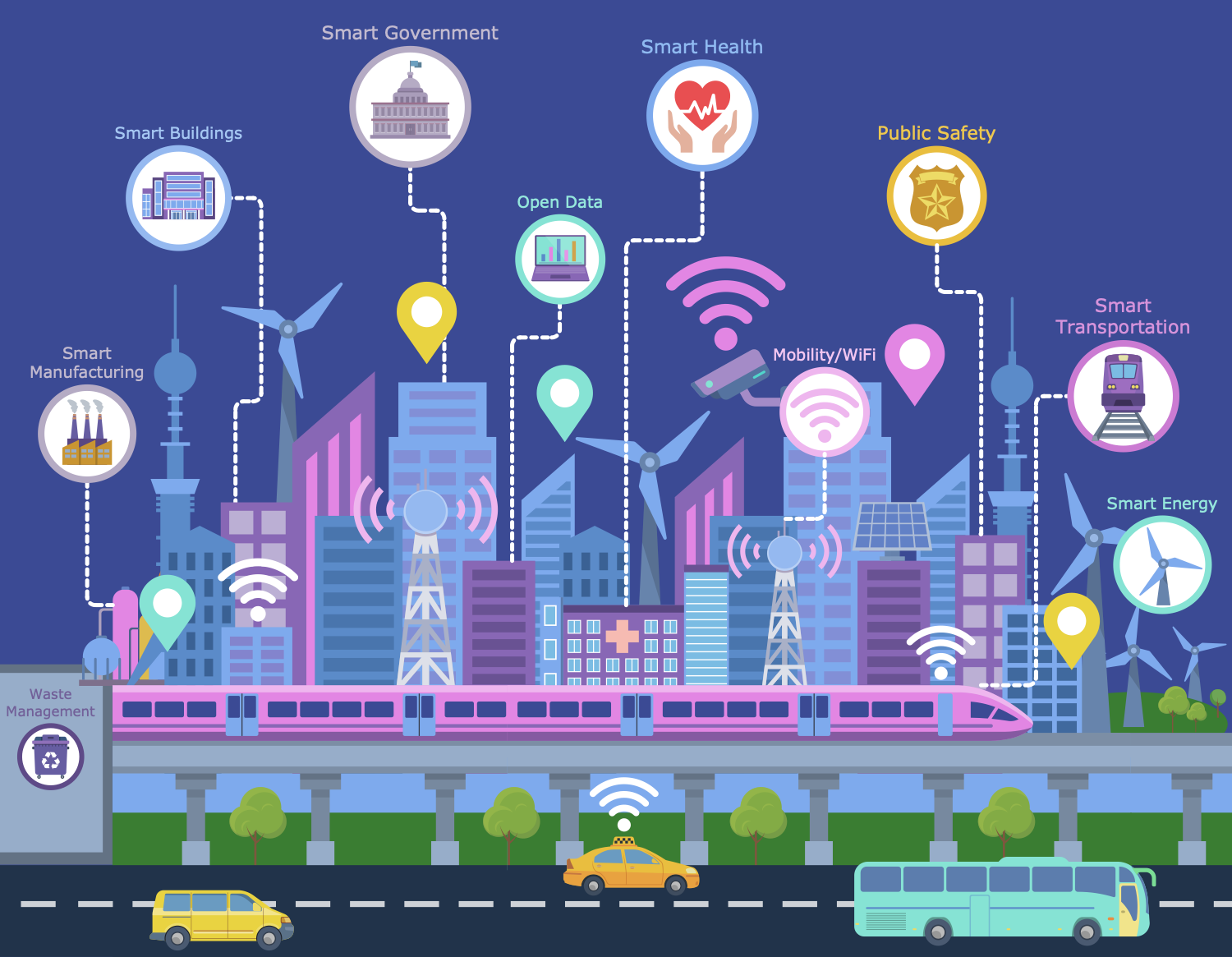
Example 14: Urban Water Cycle
This diagram was created in ConceptDraw DIAGRAM using a combination of libraries from the Critical Infrastructure Sectors Solution. An experienced user spent 10 minutes creating this sample.
This sample illustrates the urban water cycle, including urban water supply, stormwater and rainwater, wastewater and groundwater management, wastewater disposal, pumping groundwater to the surface for future use, water and wastewater collection and treatment, flood control, and sanitation services. The purity and quality of urban water, as well as careful management of water resources, are very important issues as they are a key to the health of the population and the environment. The careful and detailed planning of urban water supply takes into account the ecological, social, and economic factors, helps to restore the natural water cycle, and is a fundamental process in our daily life. It is essential to achieve sustainable and efficient management of water resources, minimize environmental destruction and other negative impacts associated with water and wastewater, and enhance the aesthetic and recreational appeal of the area. It is also important to consider that when moving through closed or confined urban landscapes that are impervious to water, stormwater cannot penetrate the soil, stay there and nourish vegetation, but flows into the sewer system. This can impact biodiversity loss and other negative impacts.
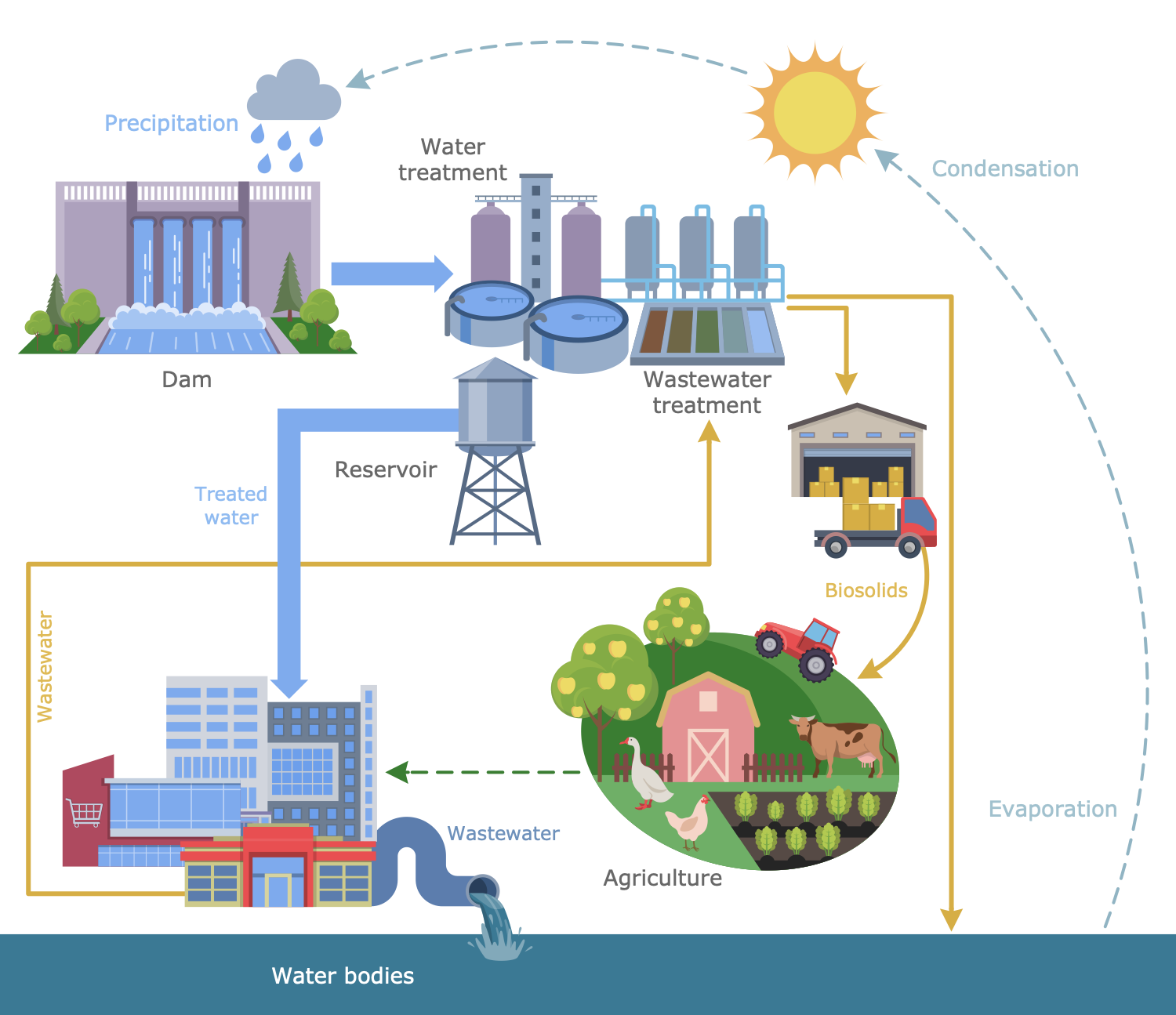
Example 15: Cybersecurity Challenges
This diagram was created in ConceptDraw DIAGRAM using a combination of libraries from the Critical Infrastructure Sectors Solution. An experienced user spent 5 minutes creating this sample.
This sample outlines key cybersecurity issues and areas of defense. Cybersecurity is an important issue nowadays due to digitalization and the wide variety of electronic devices used in everyday life. Information technology and the Internet are being introduced everywhere, offering enormous benefits and making our lives easier and more comfortable. However, at the same time, risks and threats are actively growing, mainly cyber threats in the form of cyber attacks, malware, botnets, phishing, and other malicious programs. Moreover, cyber threats and cyber attacks are becoming more frequent, sophisticated, and difficult to prevent. The main goal of cybersecurity is to organize effective protection to prevent any types of attacks and cyber threats, eliminate and reduce cyber risks, increase confidentiality and protect data from hacking, theft, and loss. These include technologies and programs for mobile security, payment security, email security, etc. To ensure network security, algorithms are used for encrypted messaging, fingerprint scanner, global secure screen, phishing passwords, key set, security lock and other methods of security, cloud security, mobile security, application security, Internet of Things security, banking system security, critical infrastructure cyber security, etc.
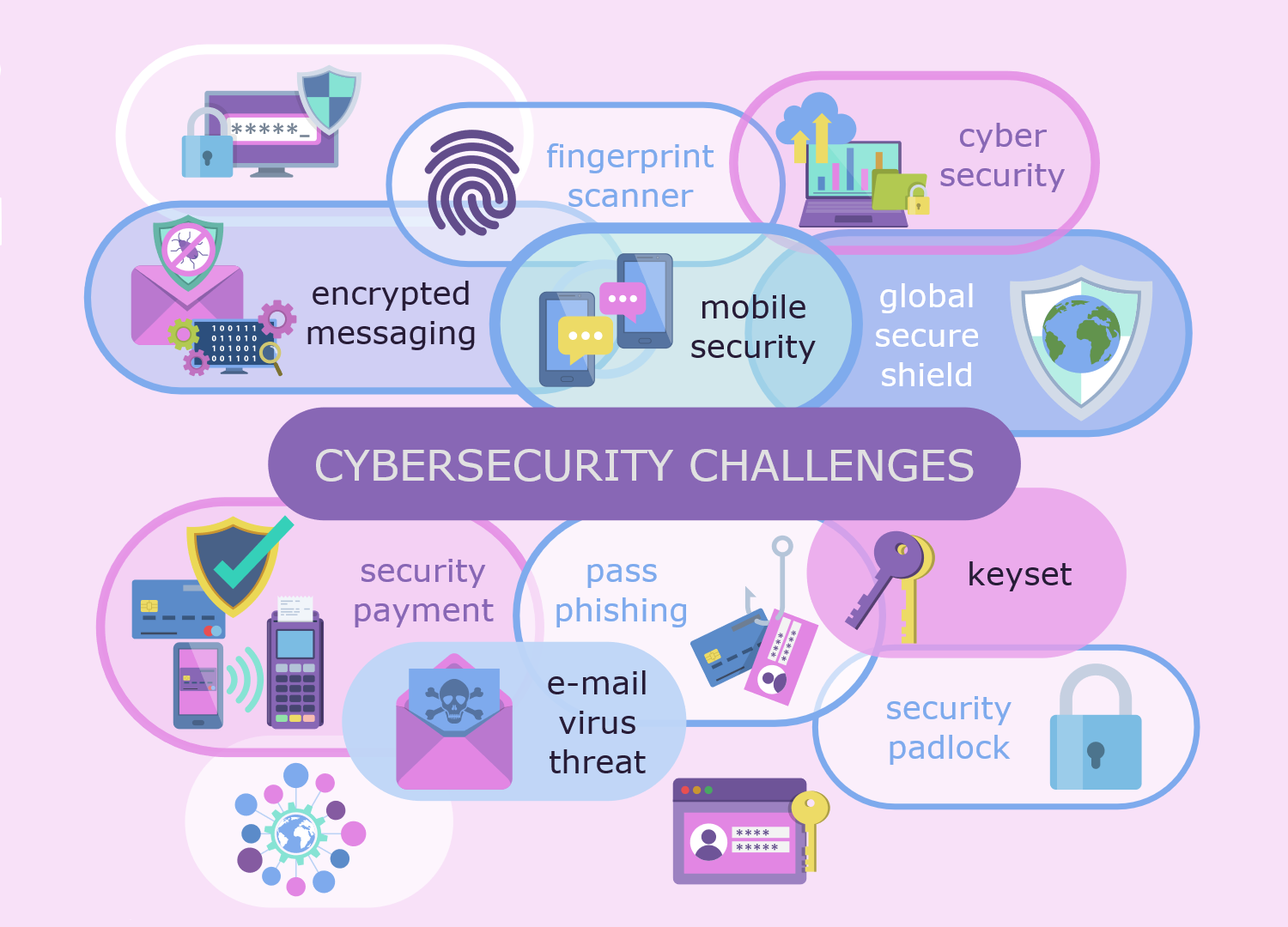
Inside

What I Need to Get Started
After ConceptDraw DIAGRAM is installed, the Critical Infrastructure Sectors solution can be purchased either from the Management area of ConceptDraw STORE itself or from our online store. Thus, you will be able to use the Critical Infrastructure Sectors solution straight after.
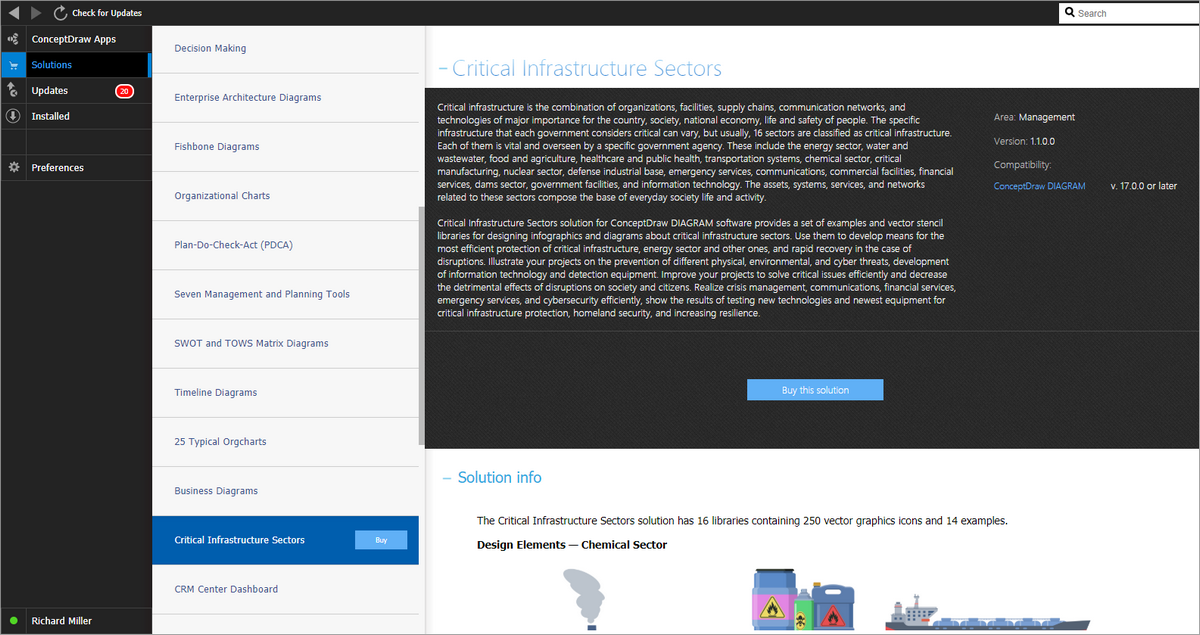
How to install
First of all, make sure that both ConceptDraw STORE and ConceptDraw DIAGRAM applications are downloaded and installed on your computer. Next, install the Critical Infrastructure Sectors solution from the ConceptDraw STORE to use it in the ConceptDraw DIAGRAM application.
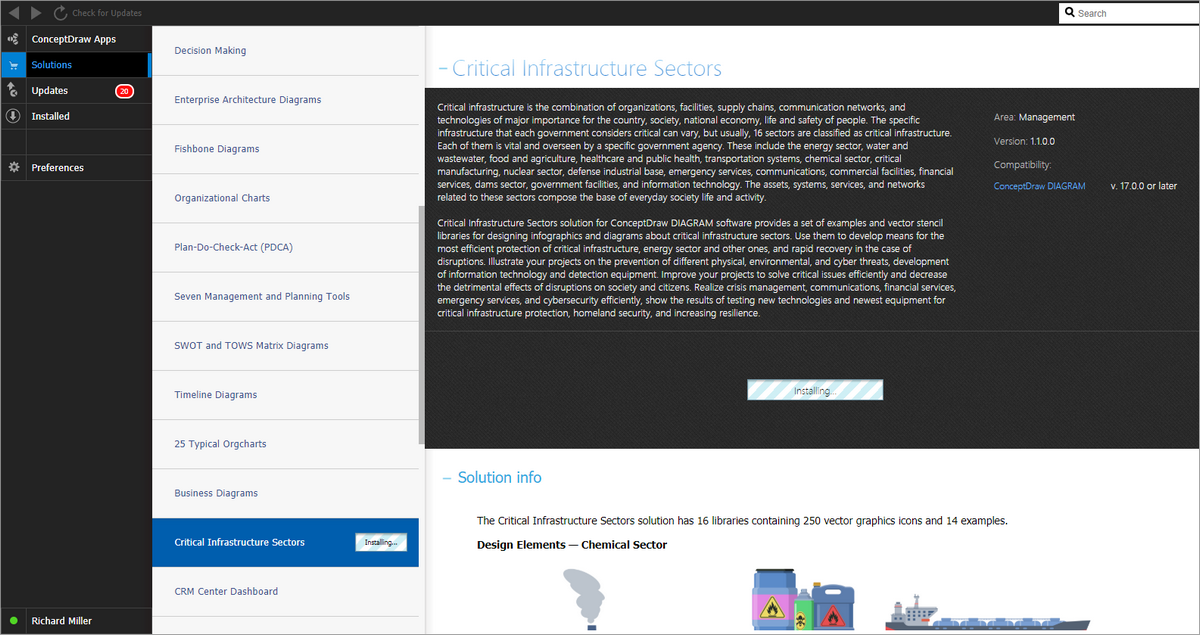
Start using
Using the Critical Infrastructure Sectors solution, by adding design elements taken from template libraries, and editing pre-made examples, improve your projects to solve critical issues efficiently.
